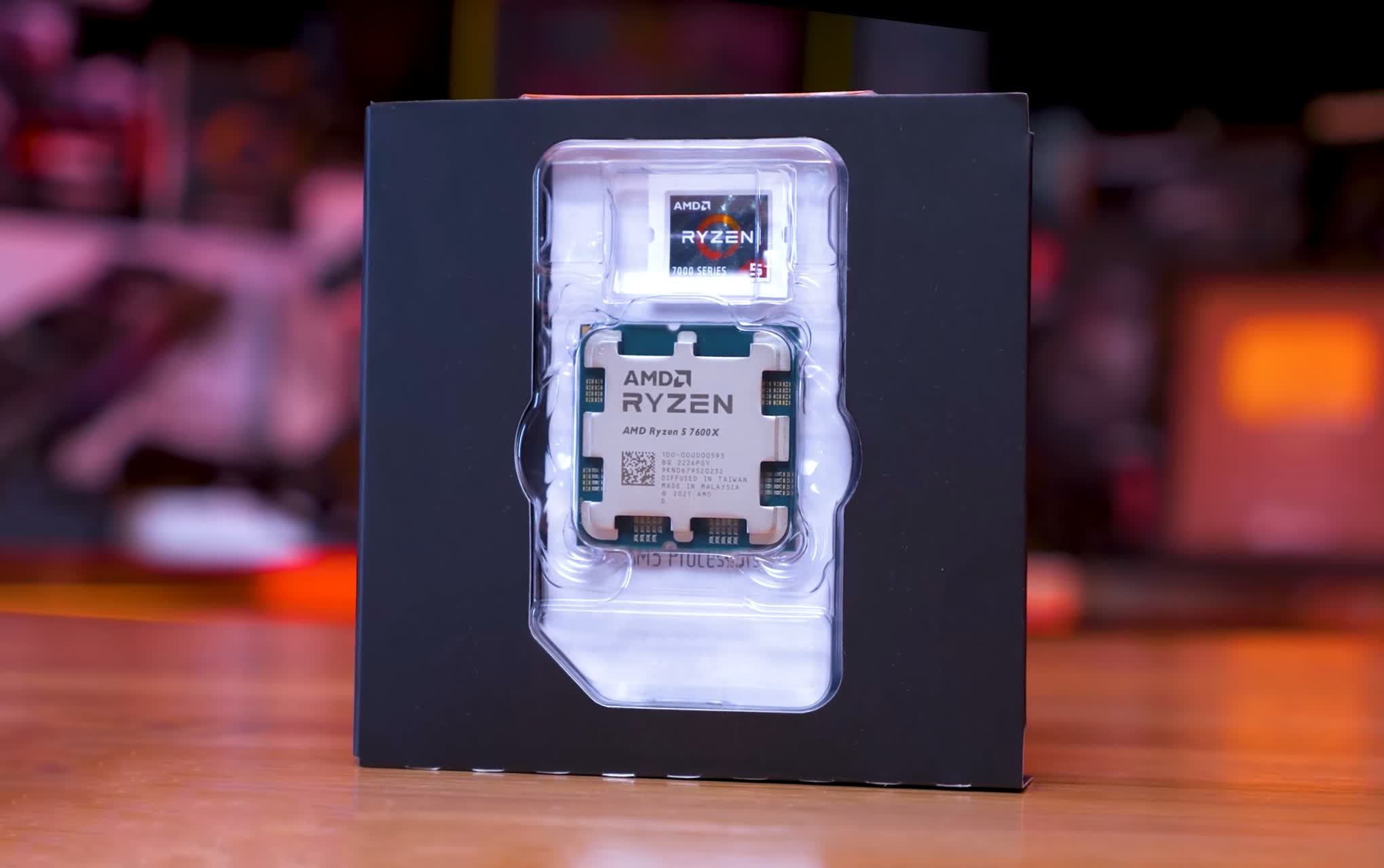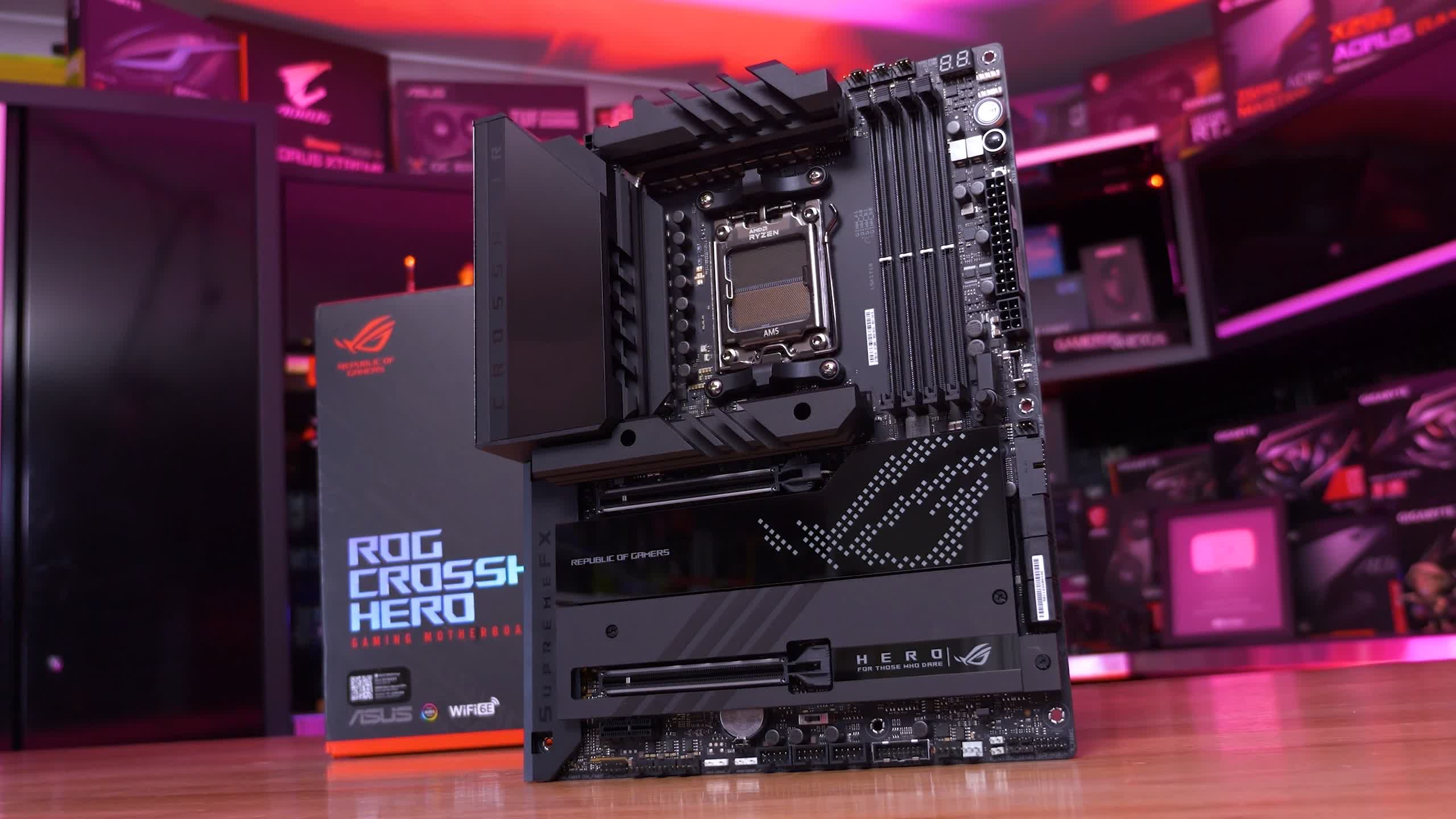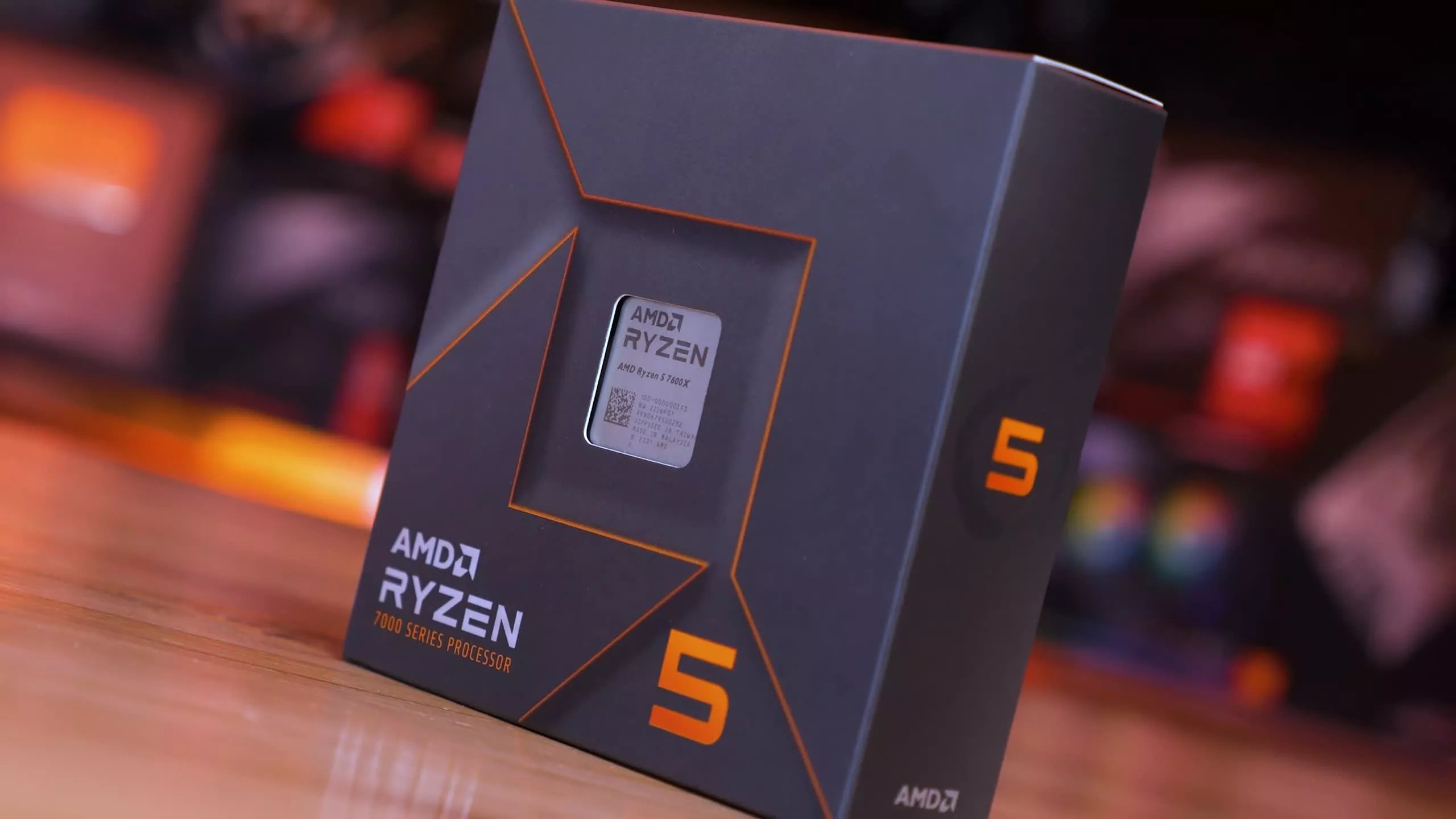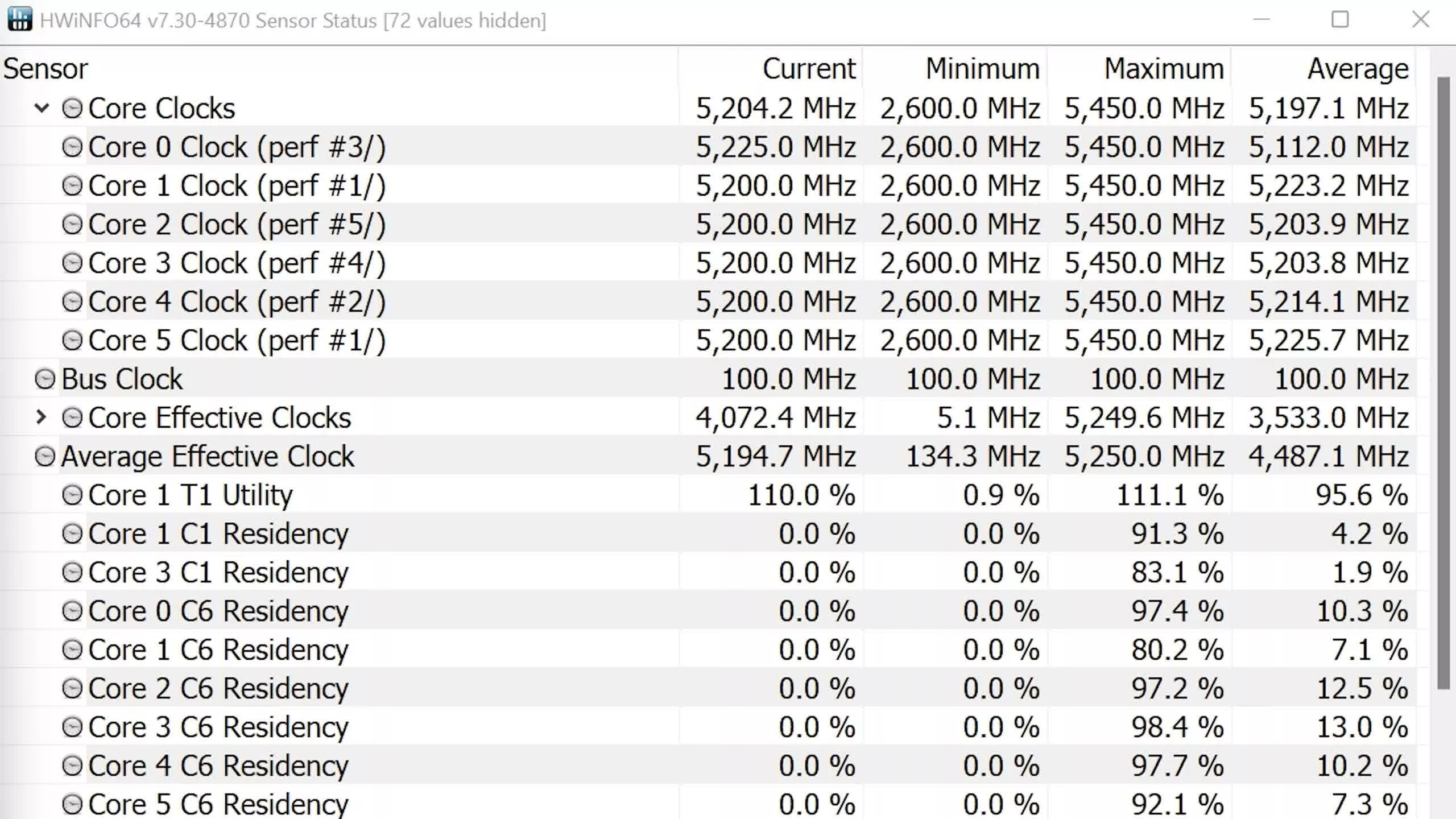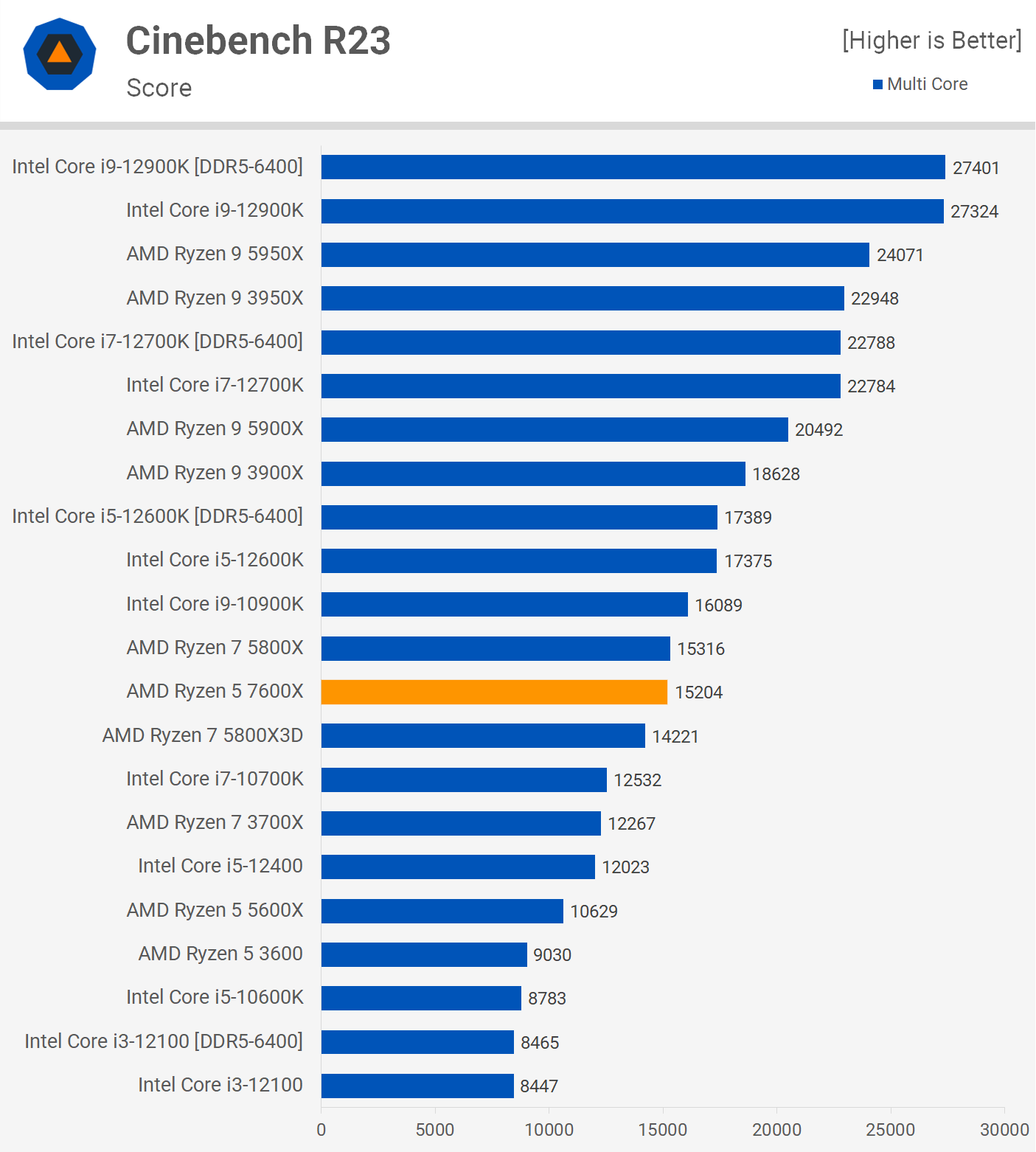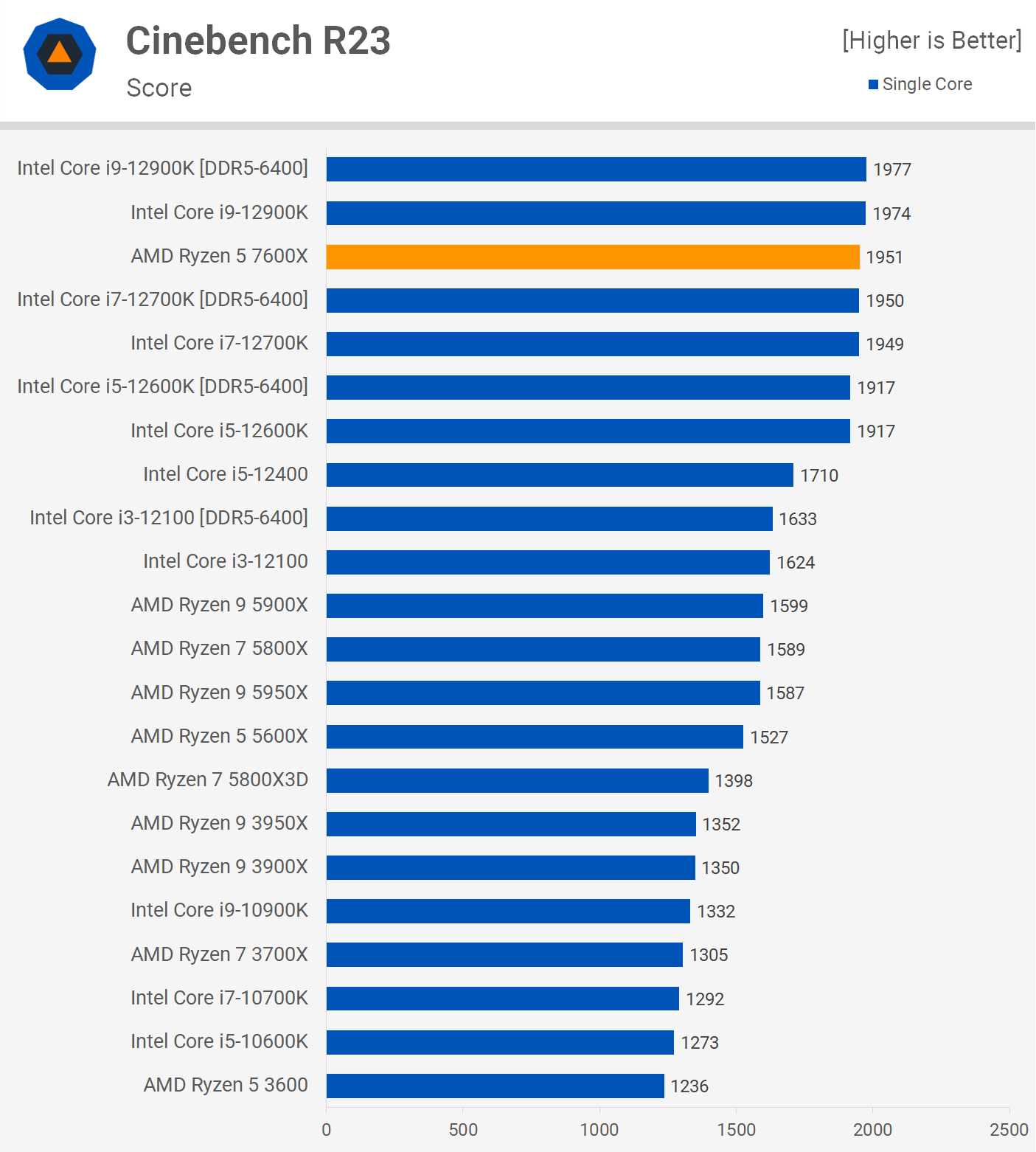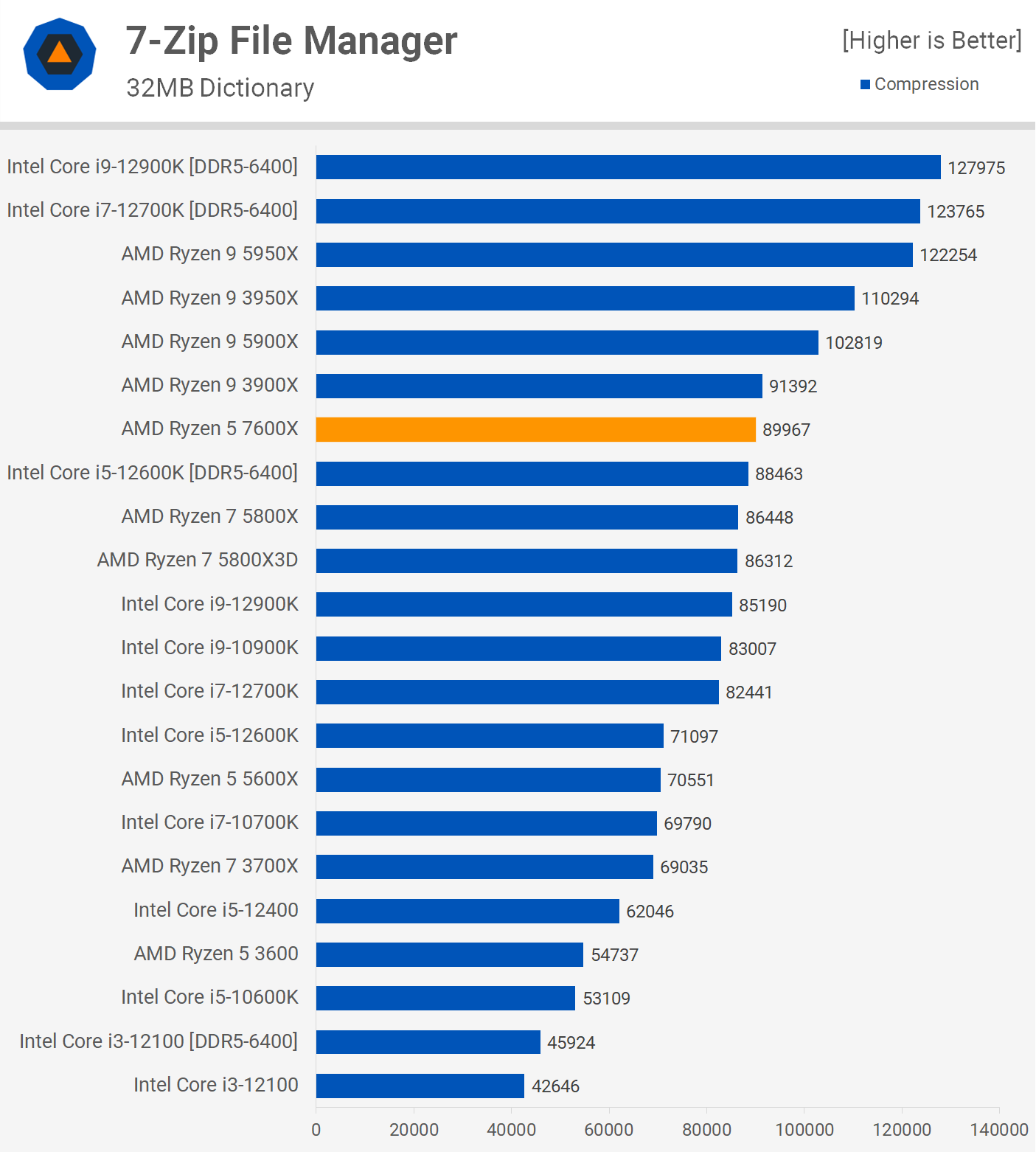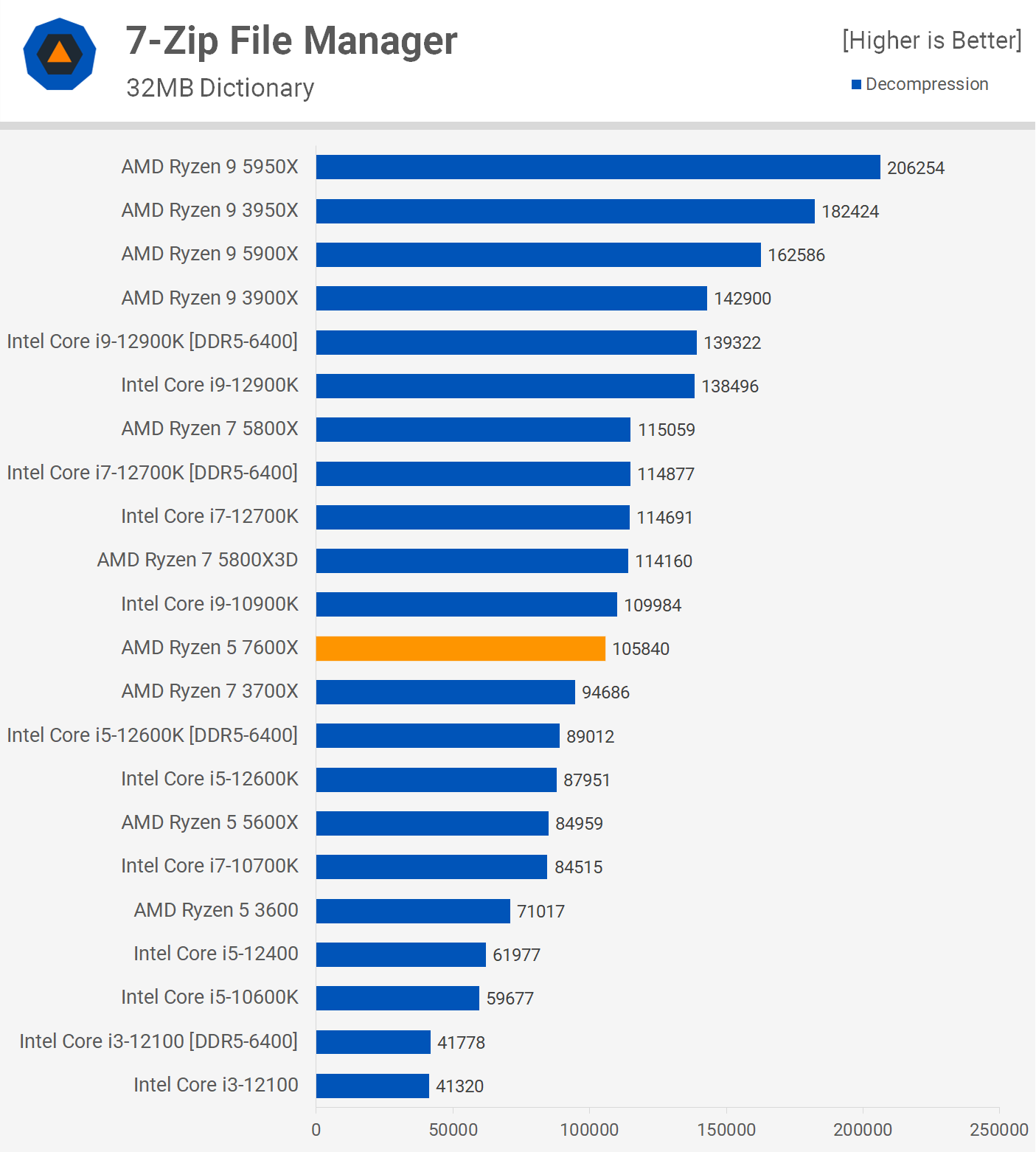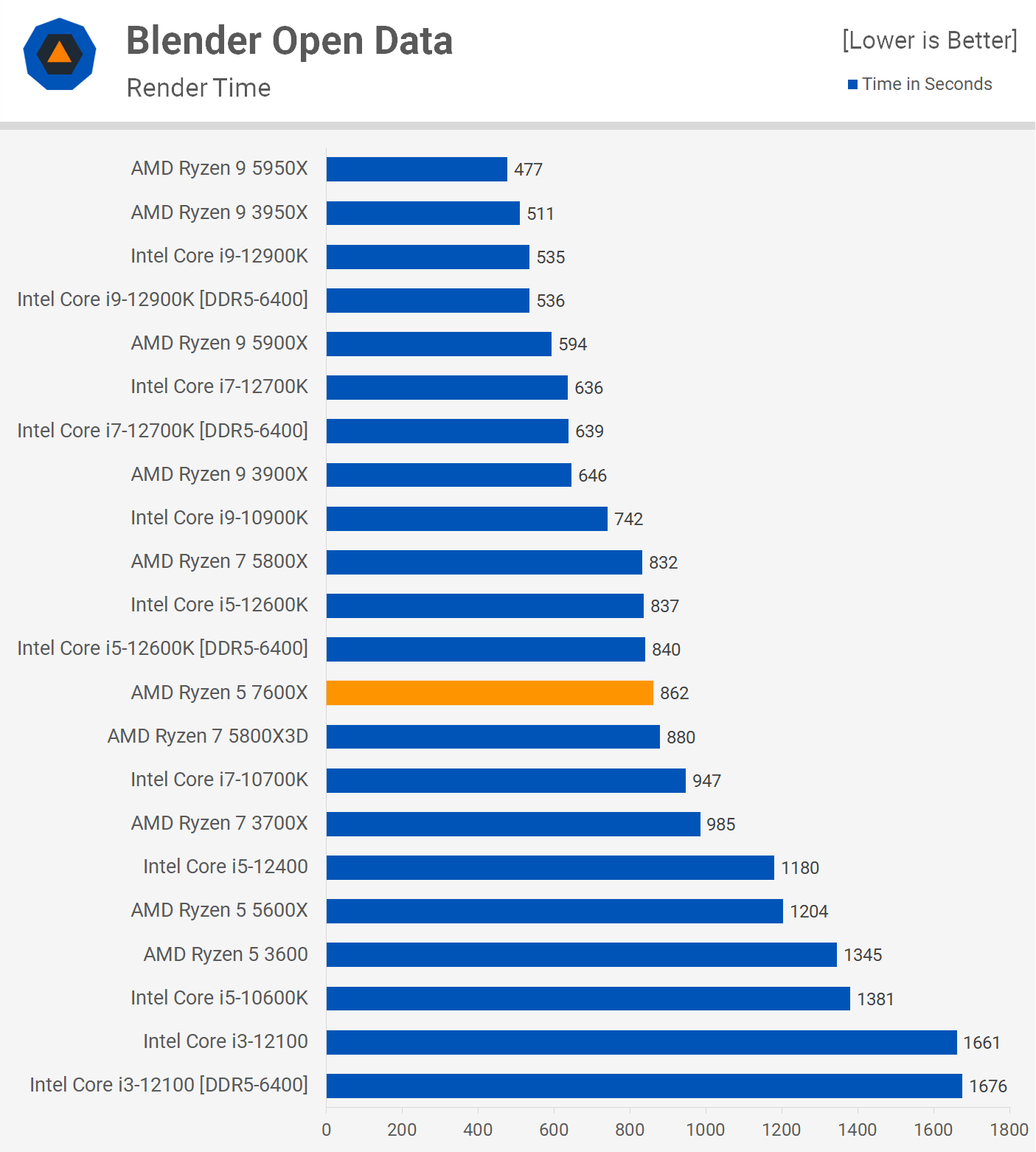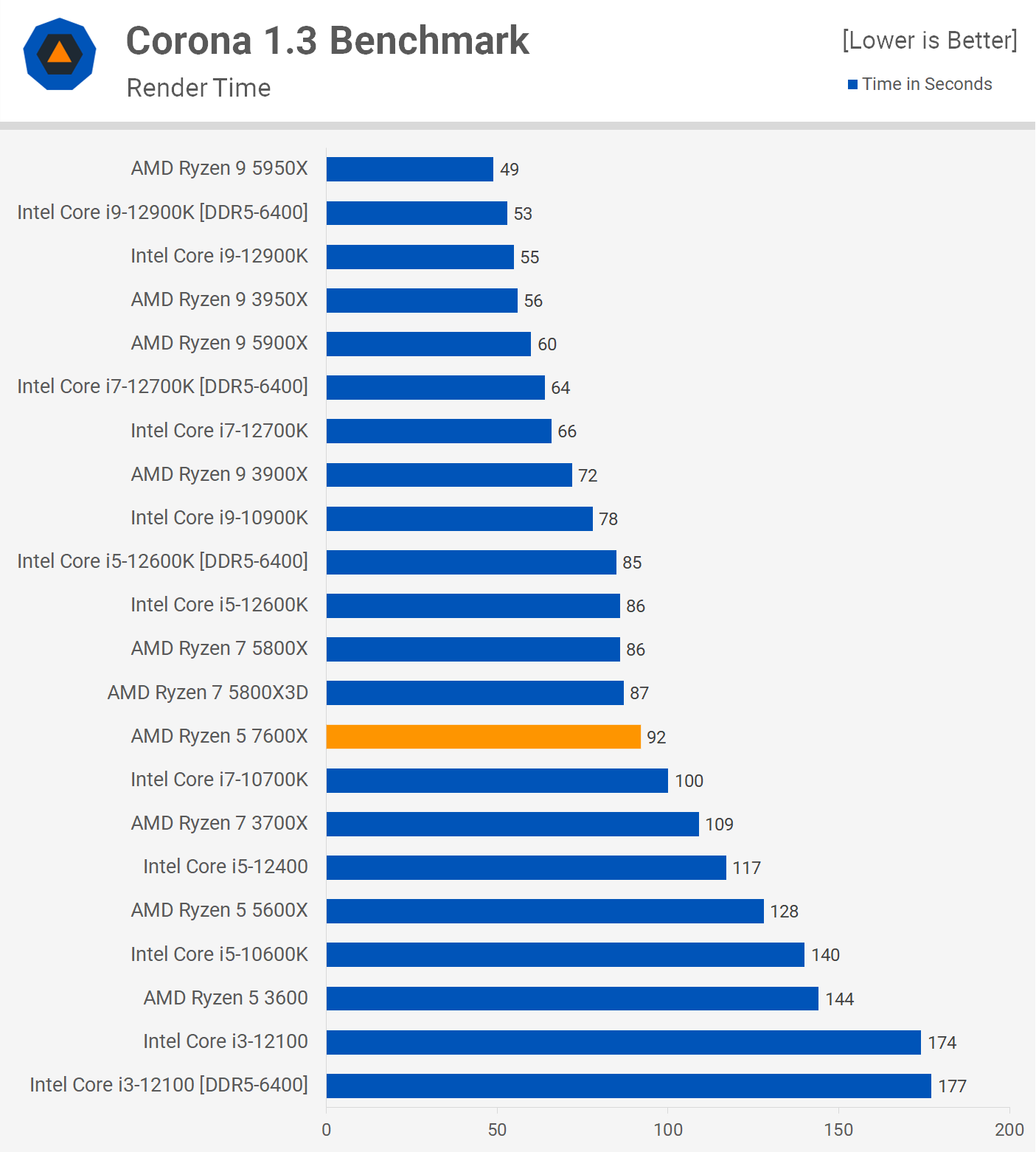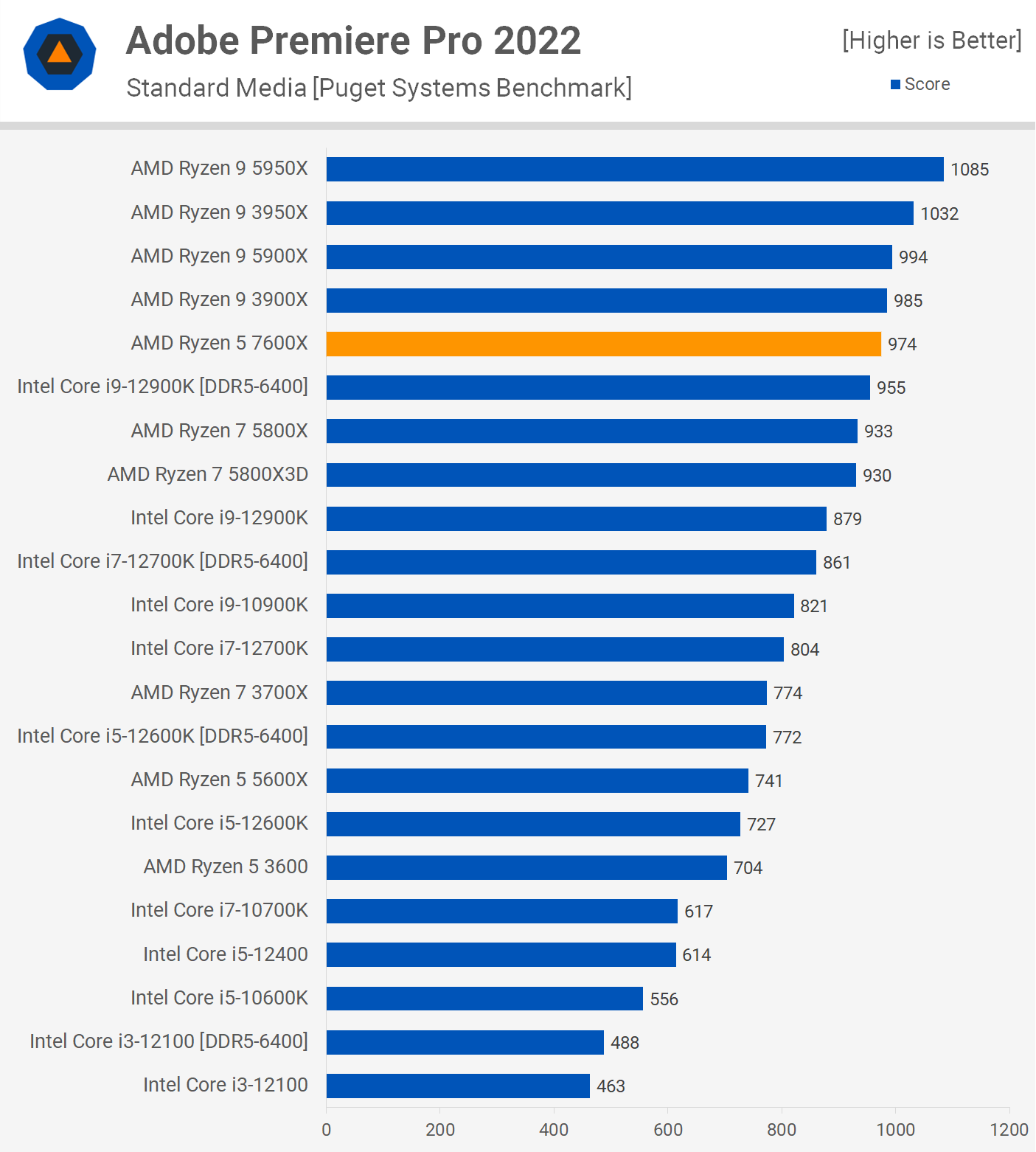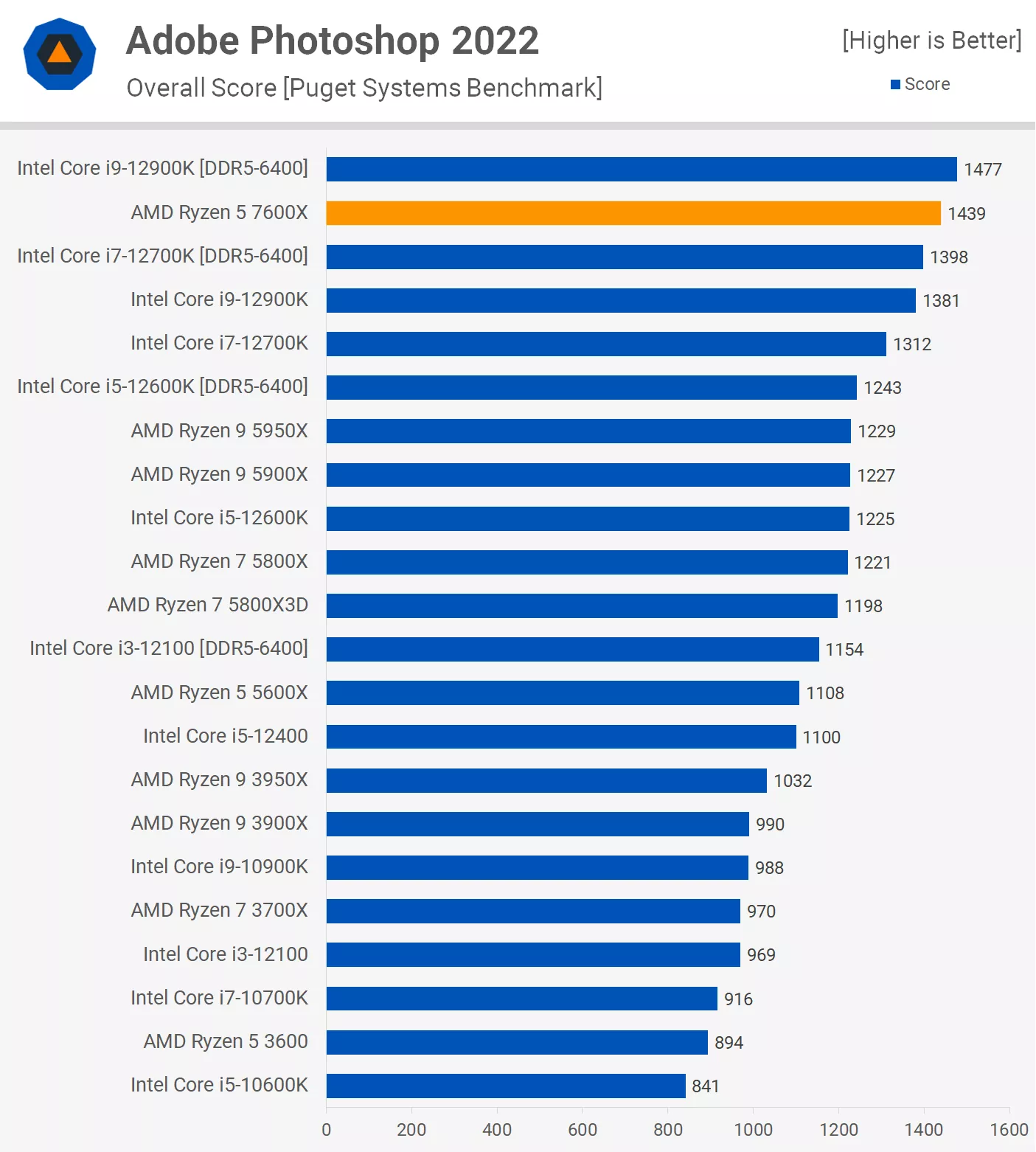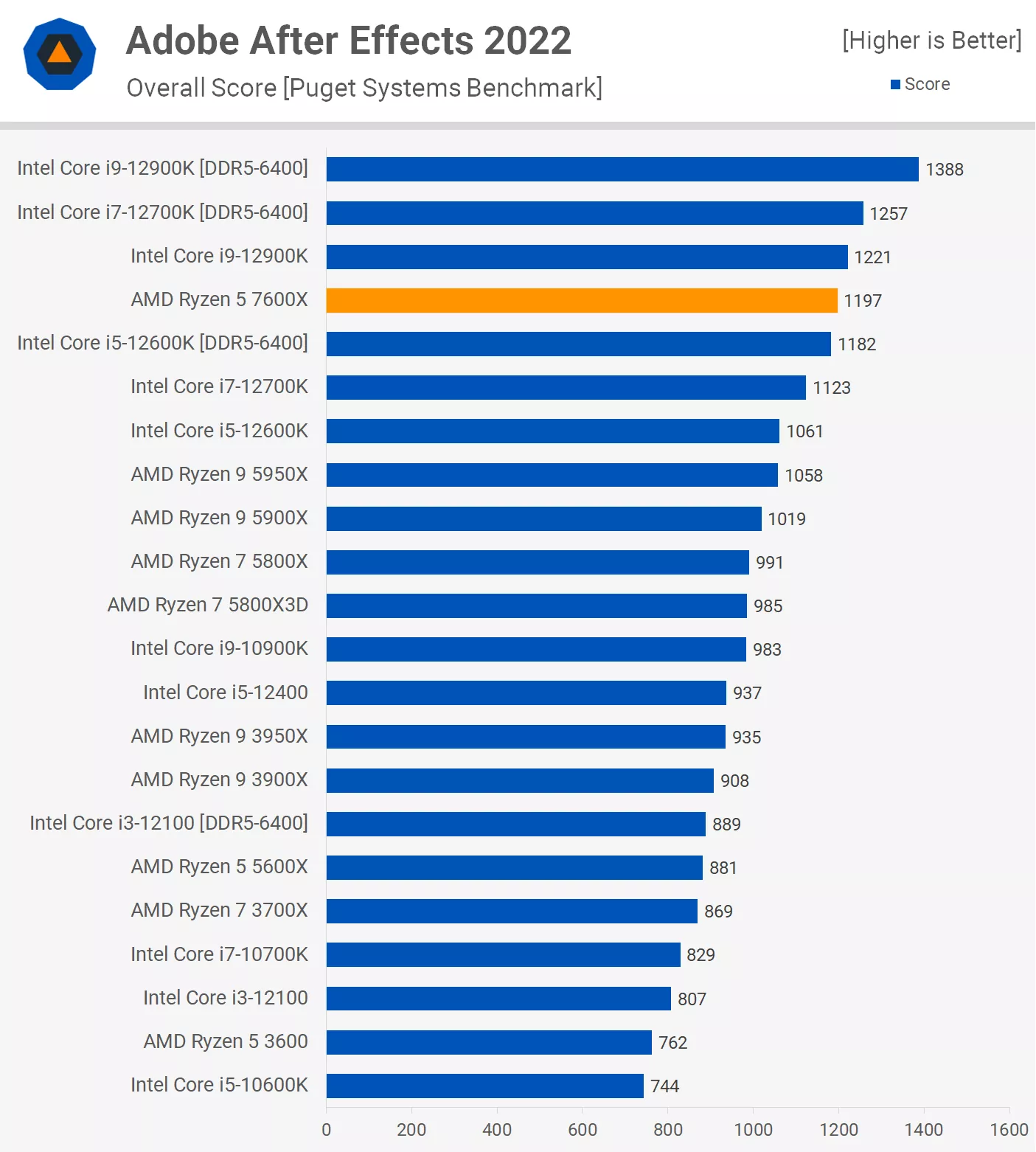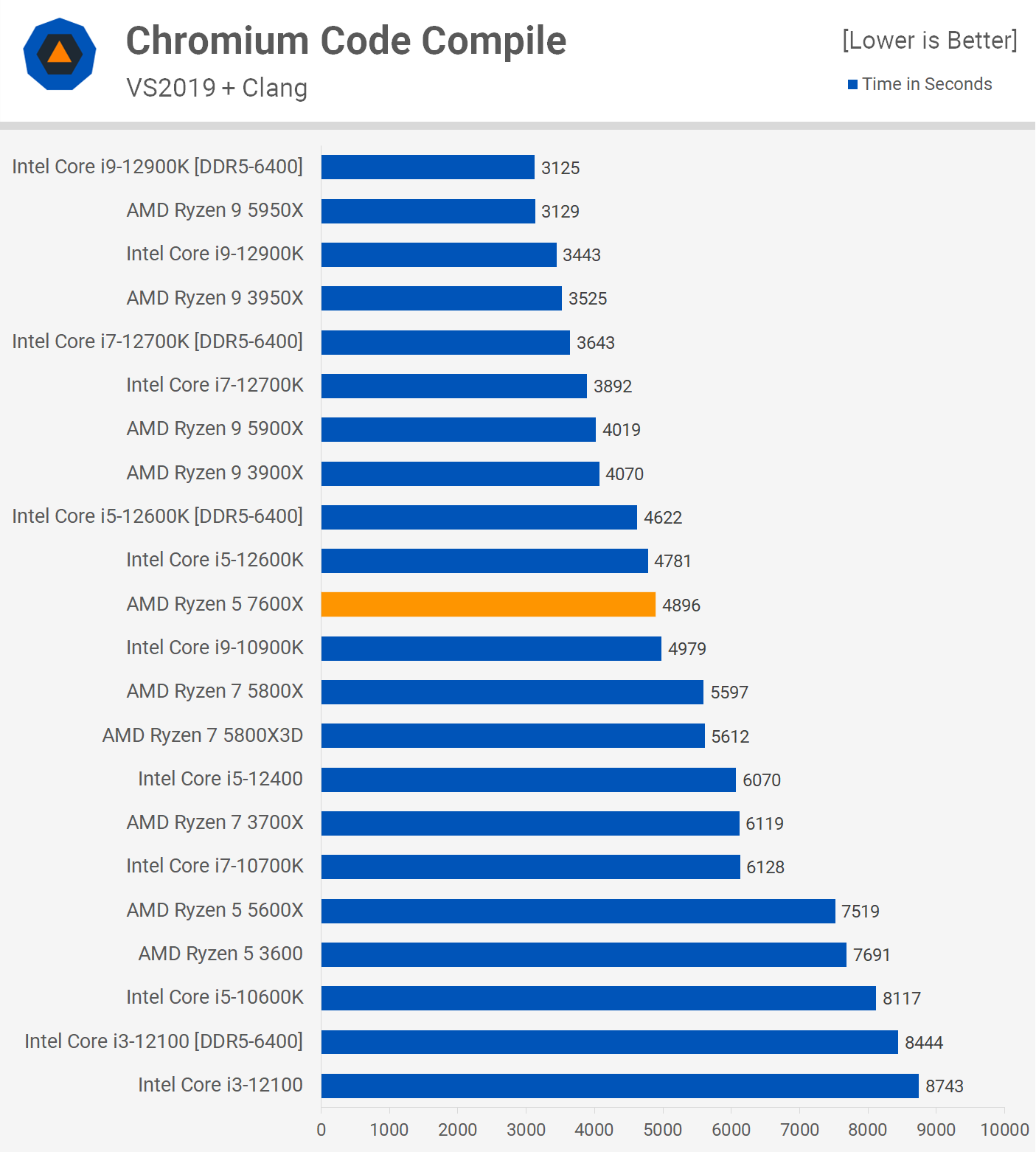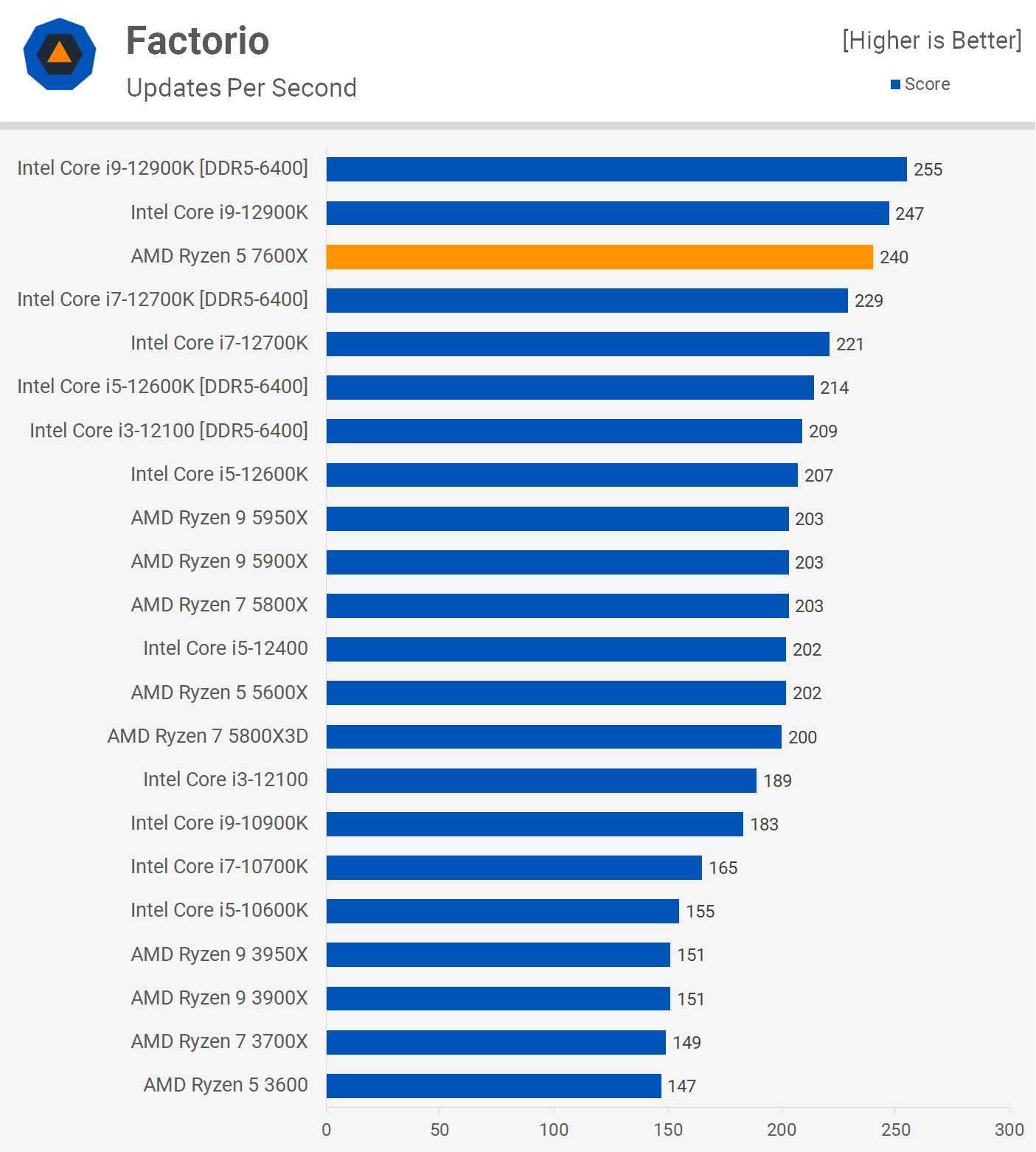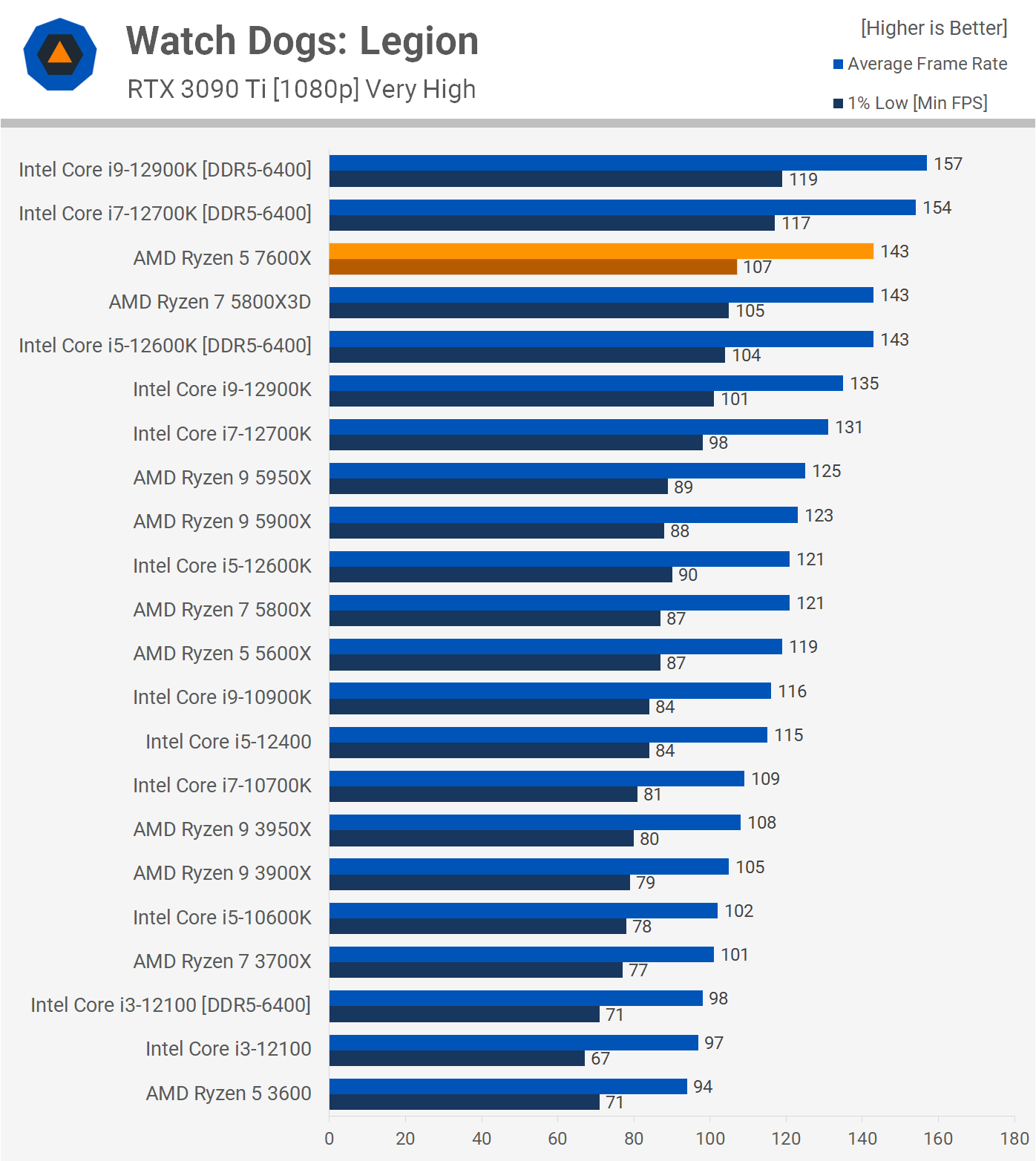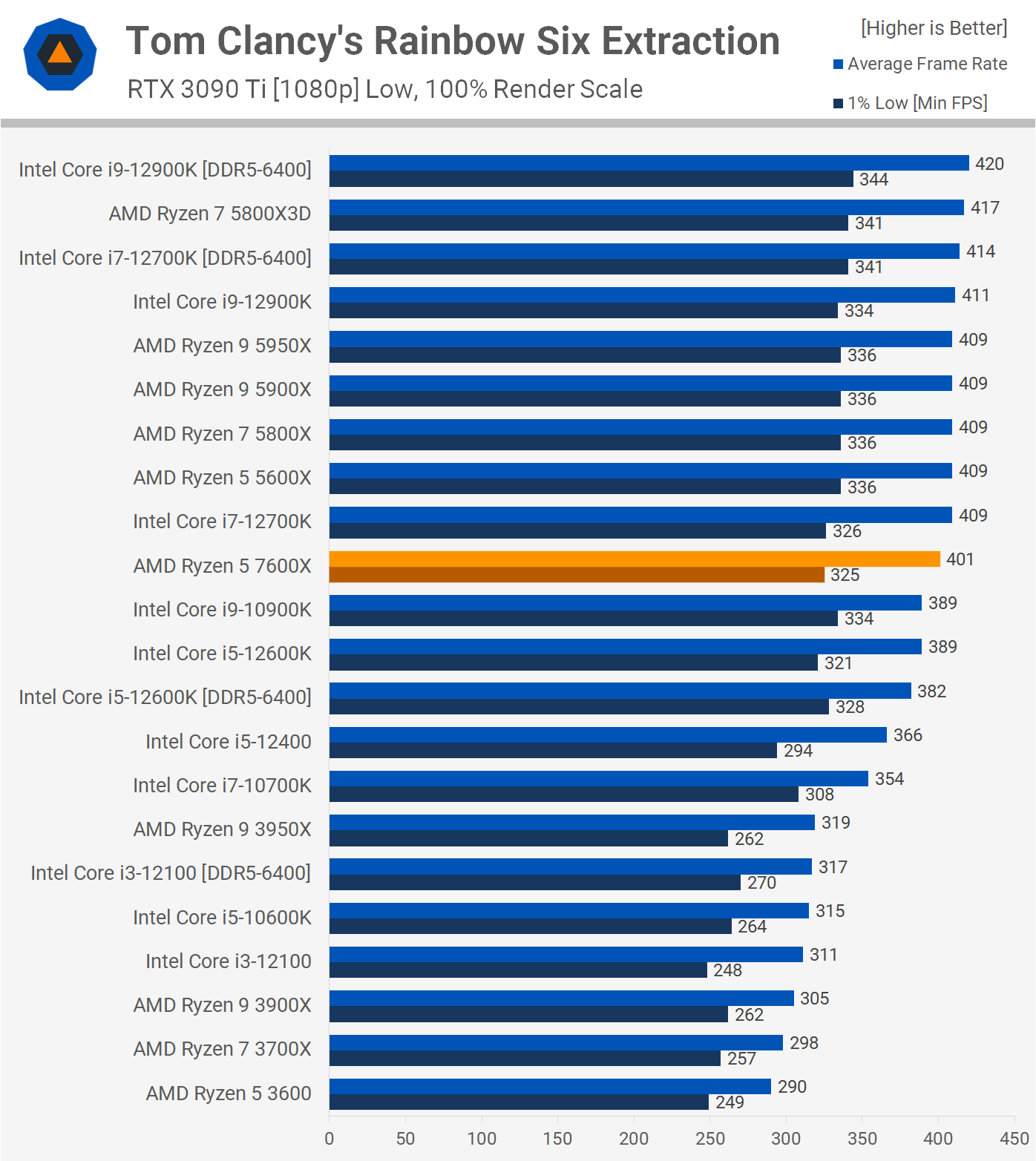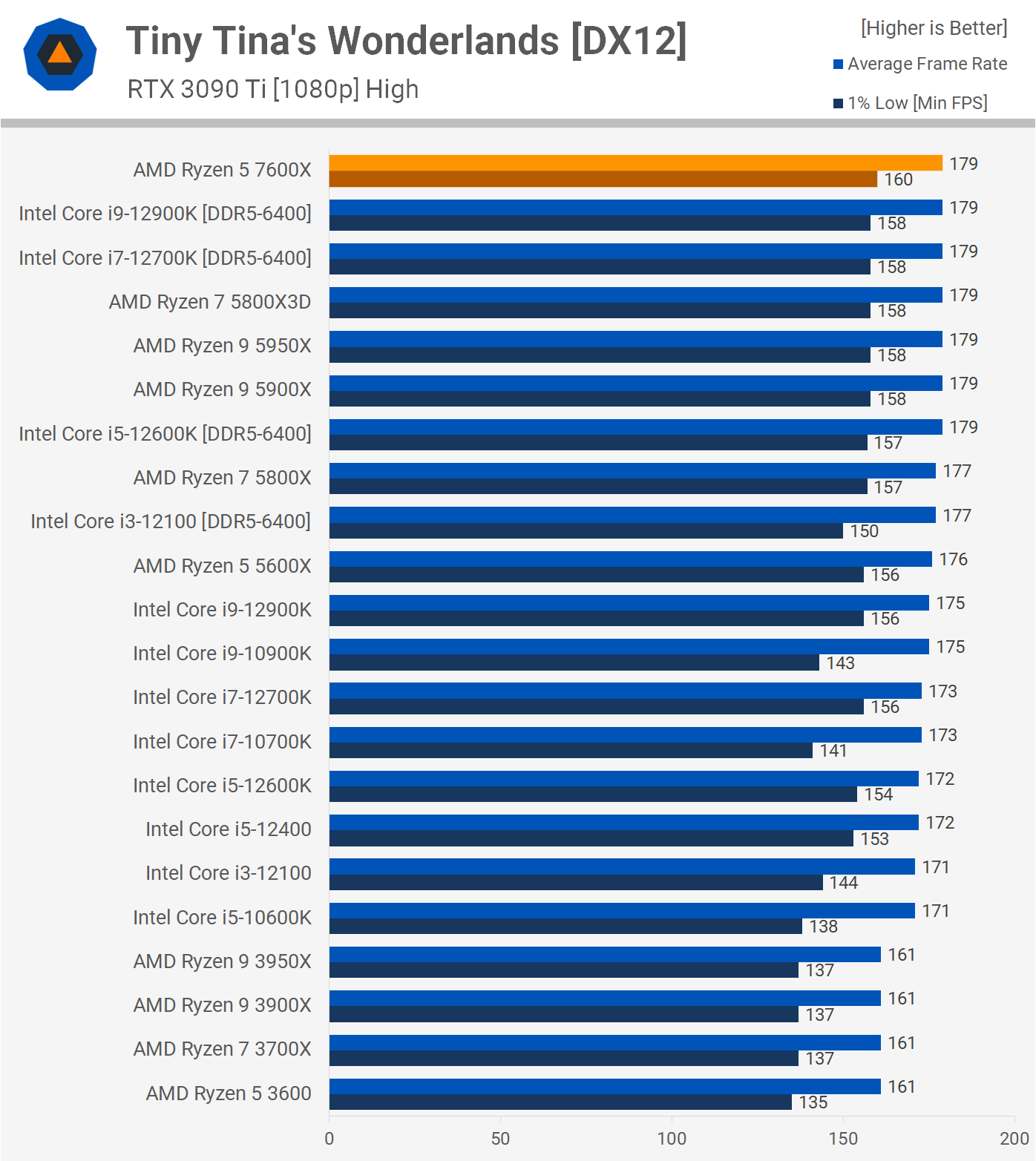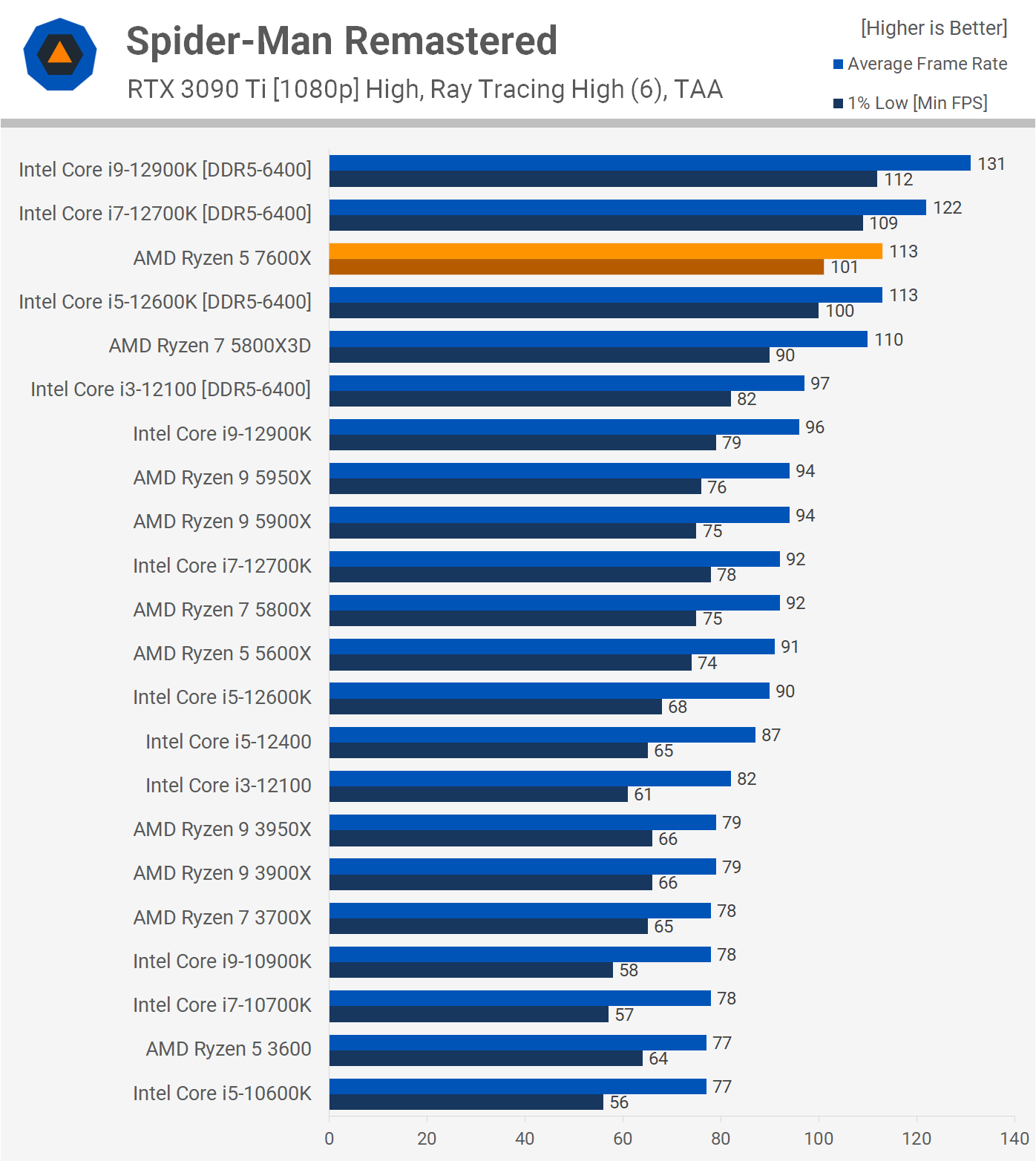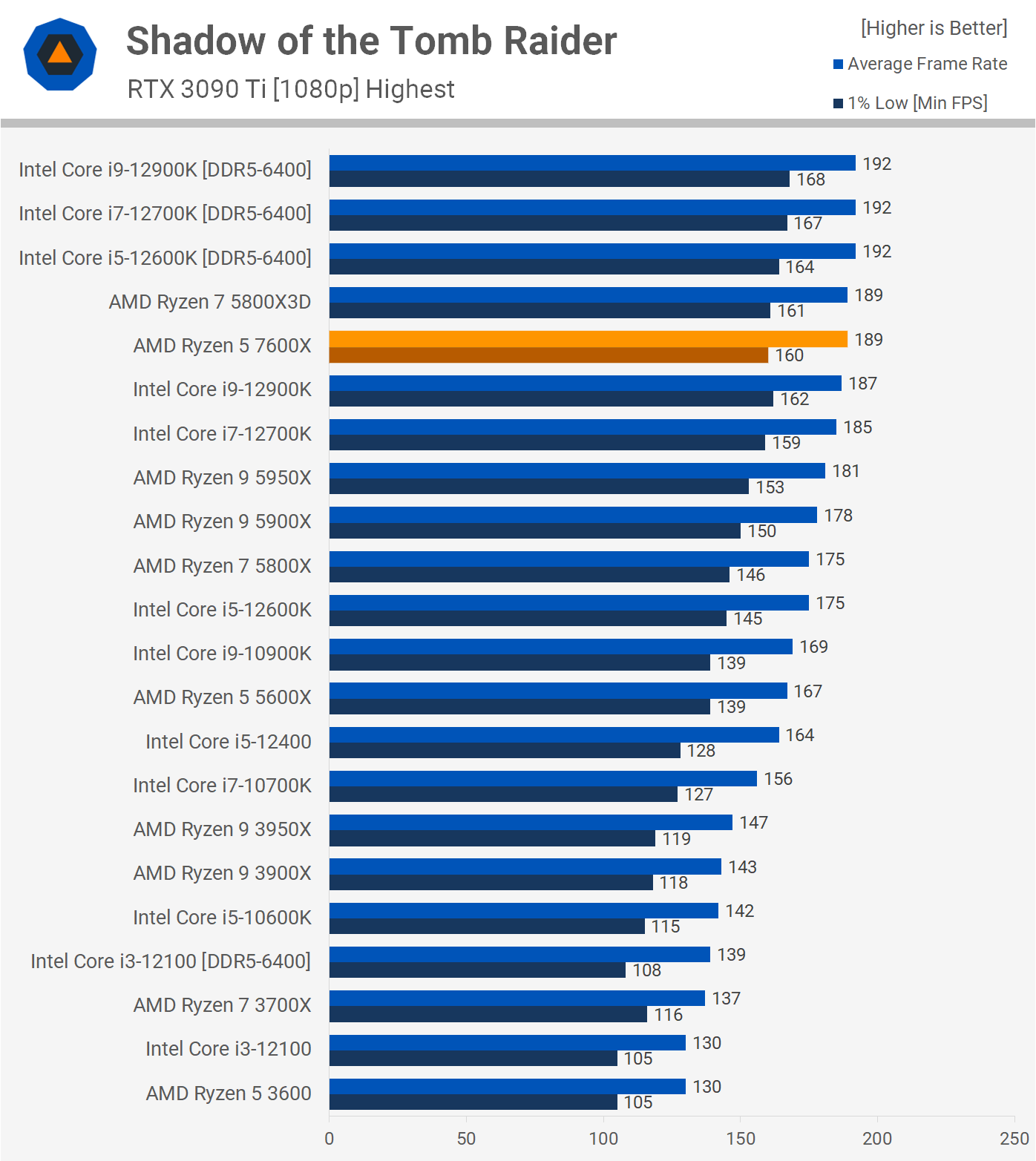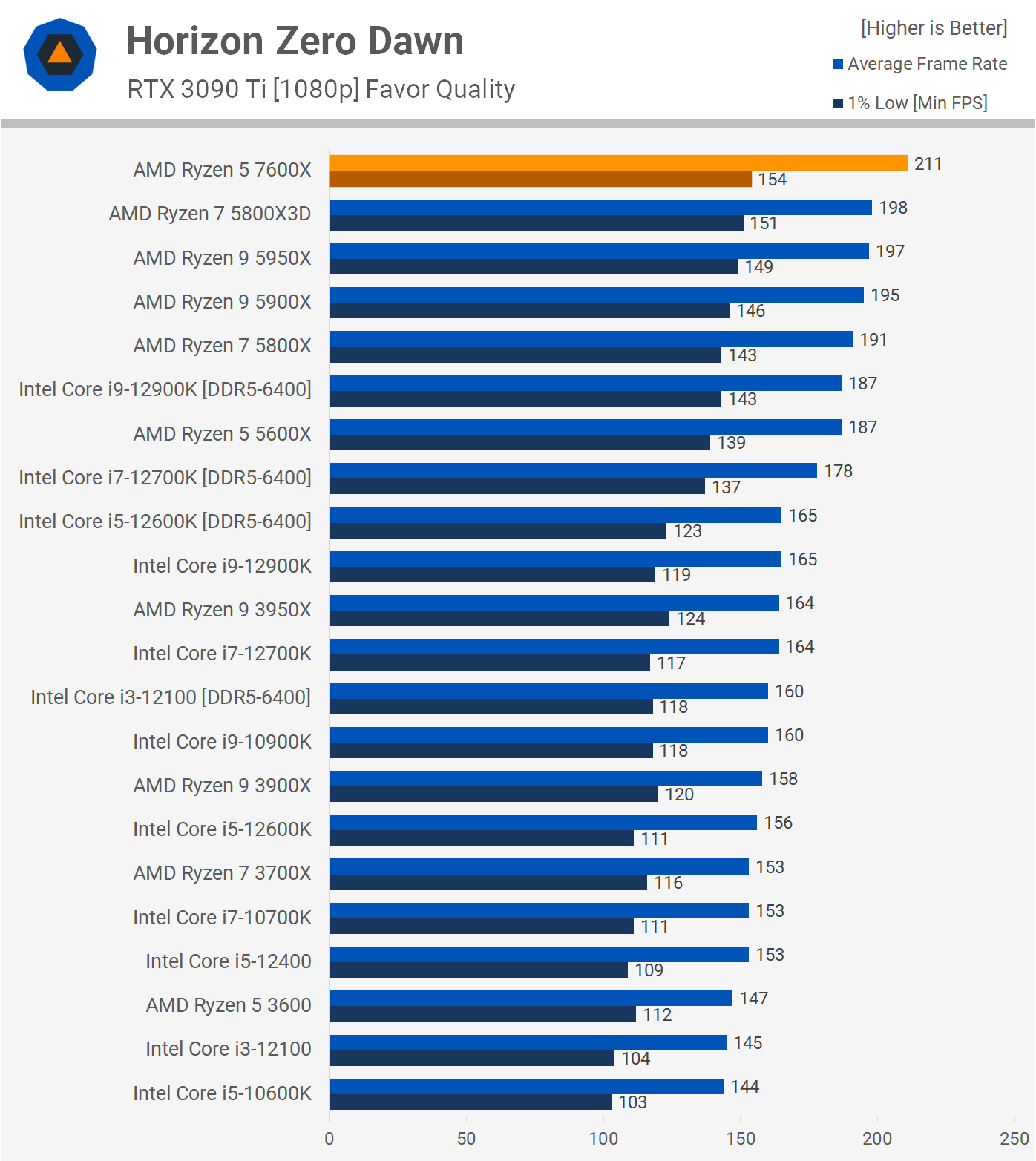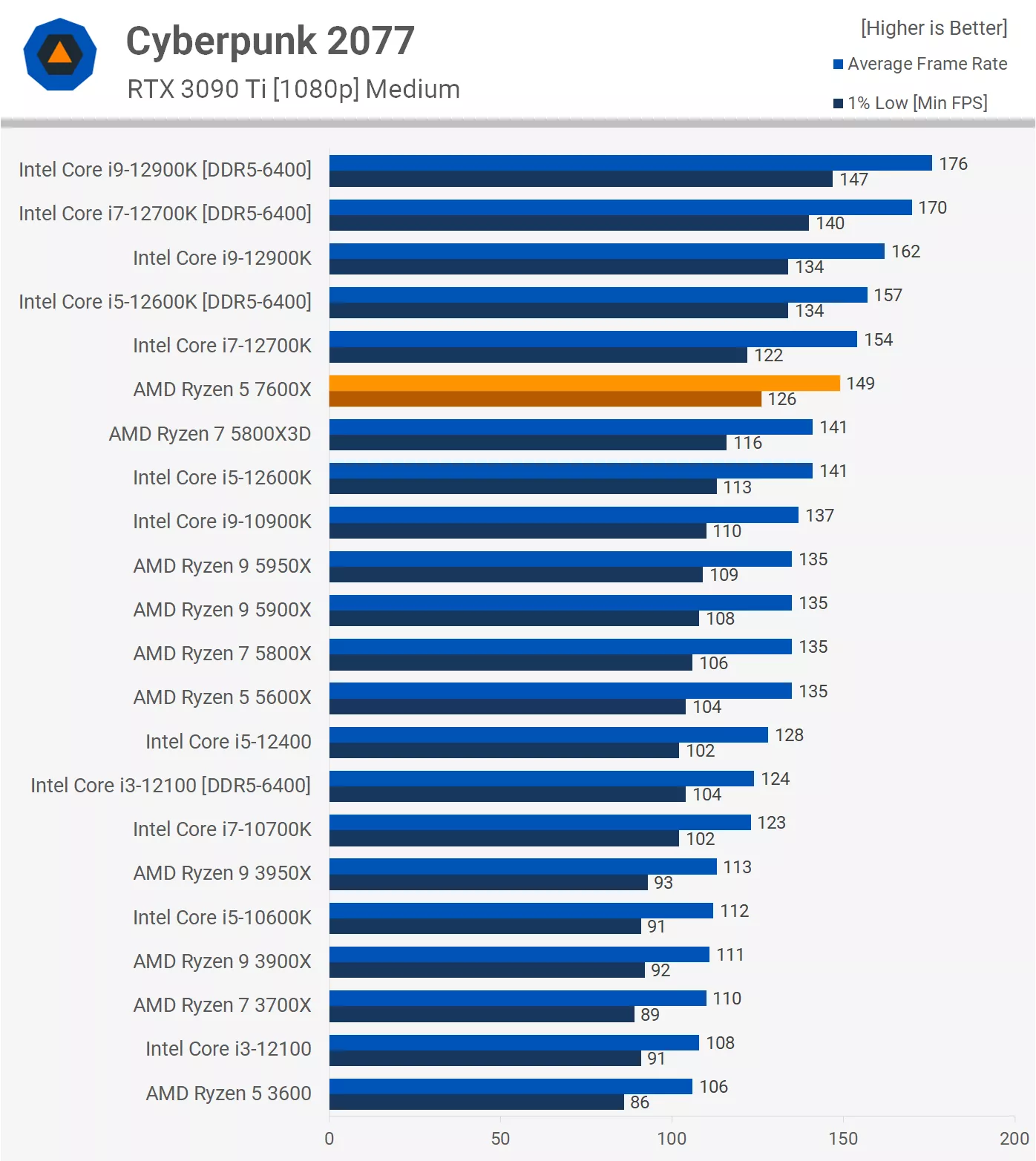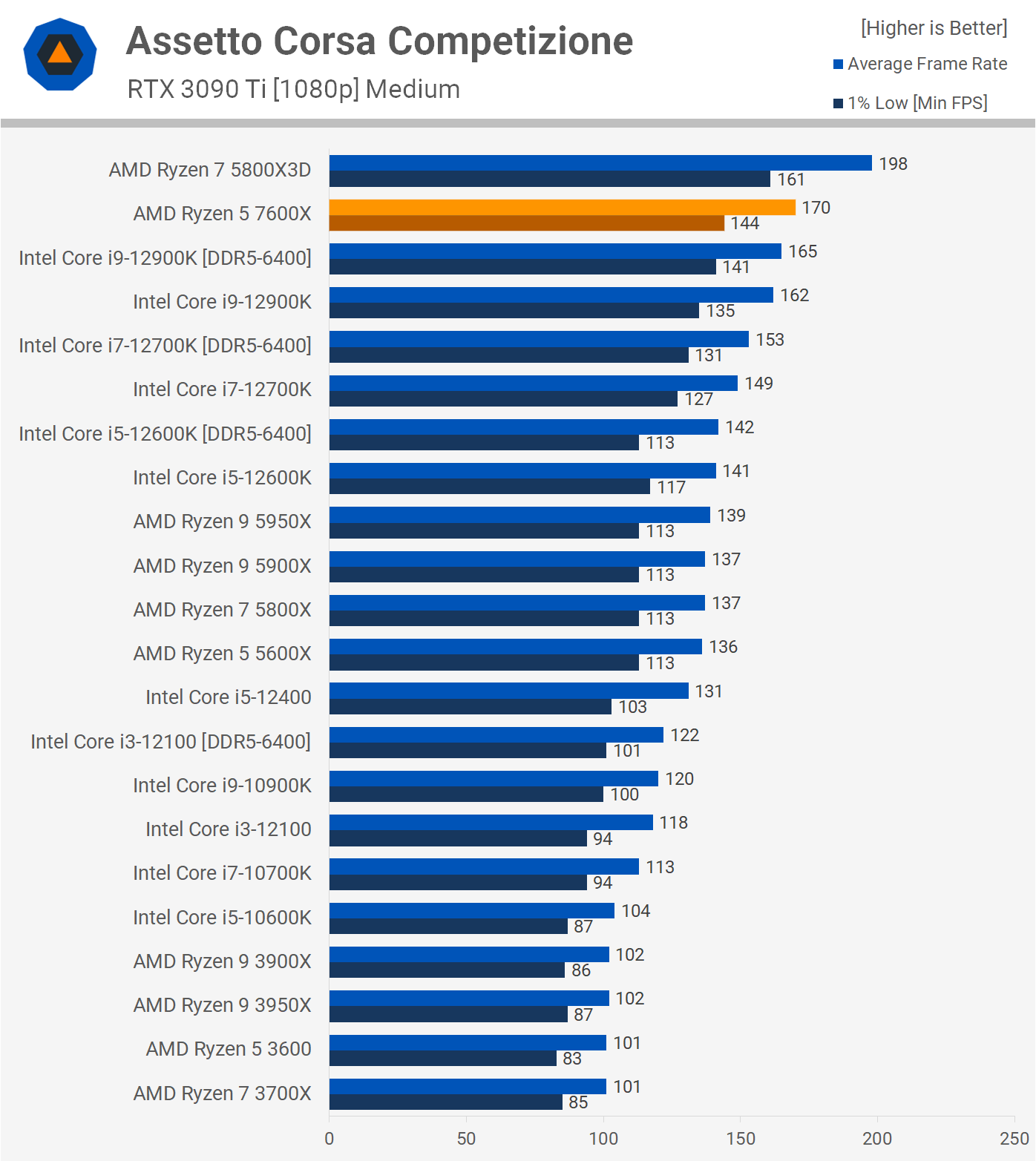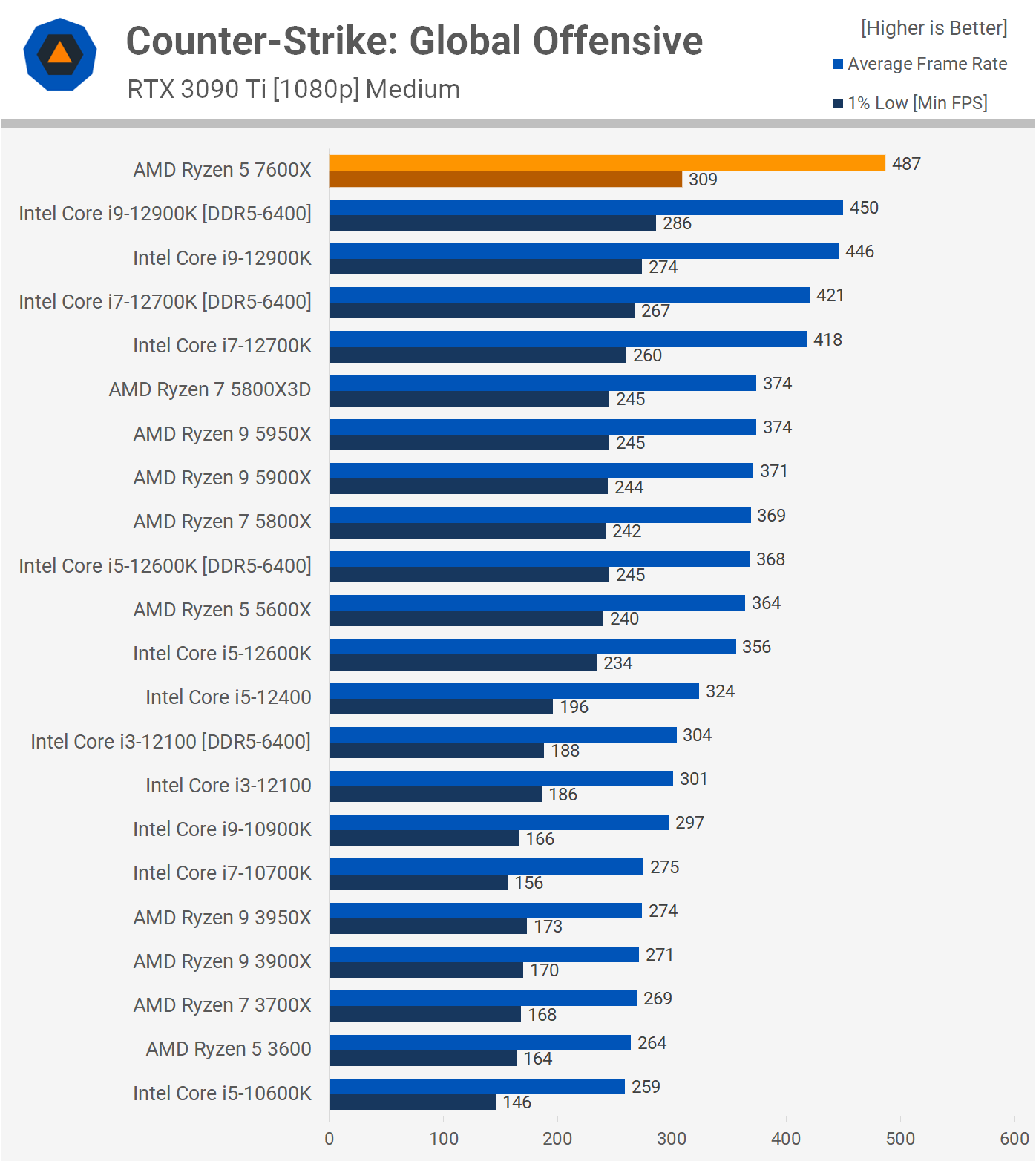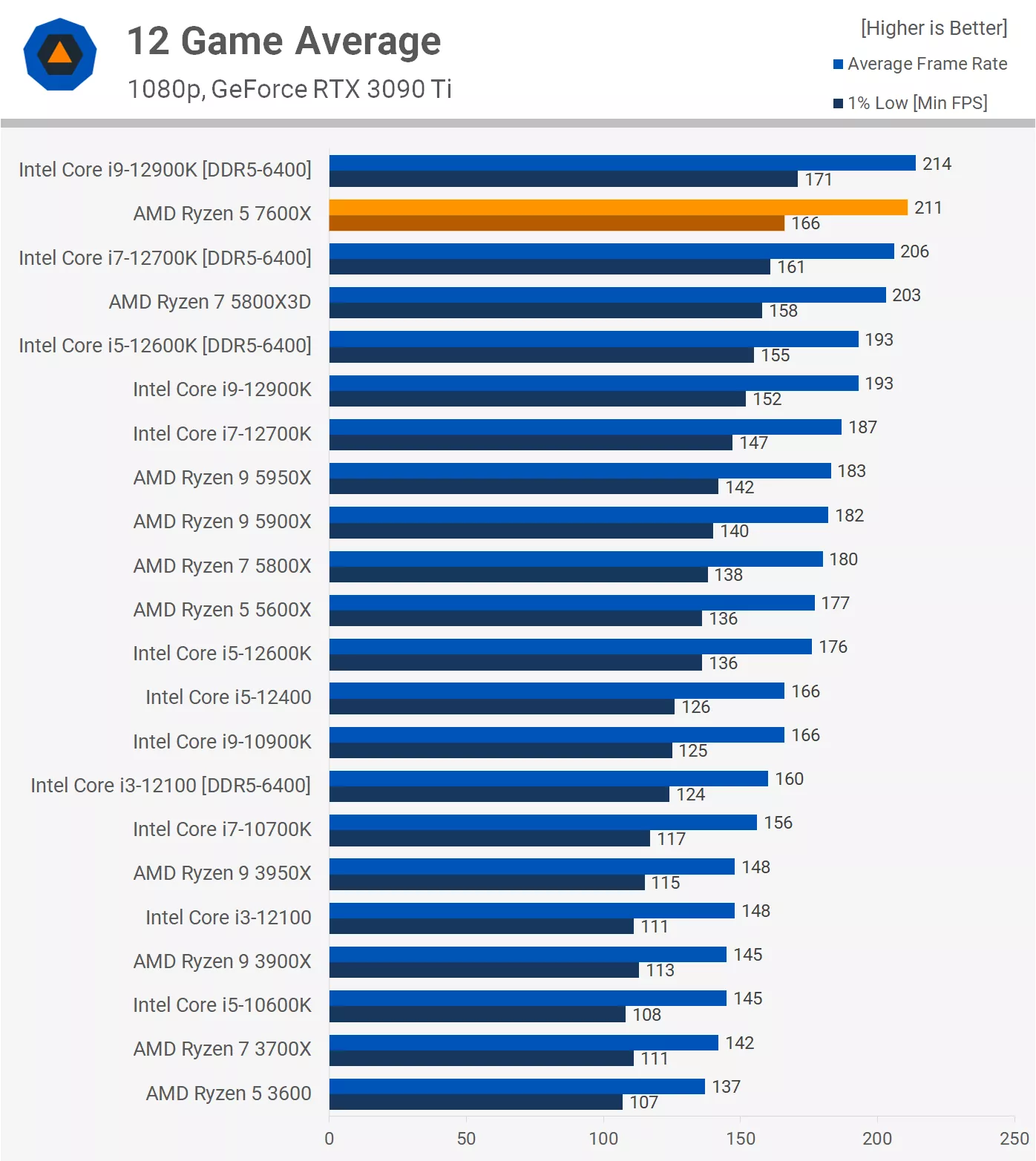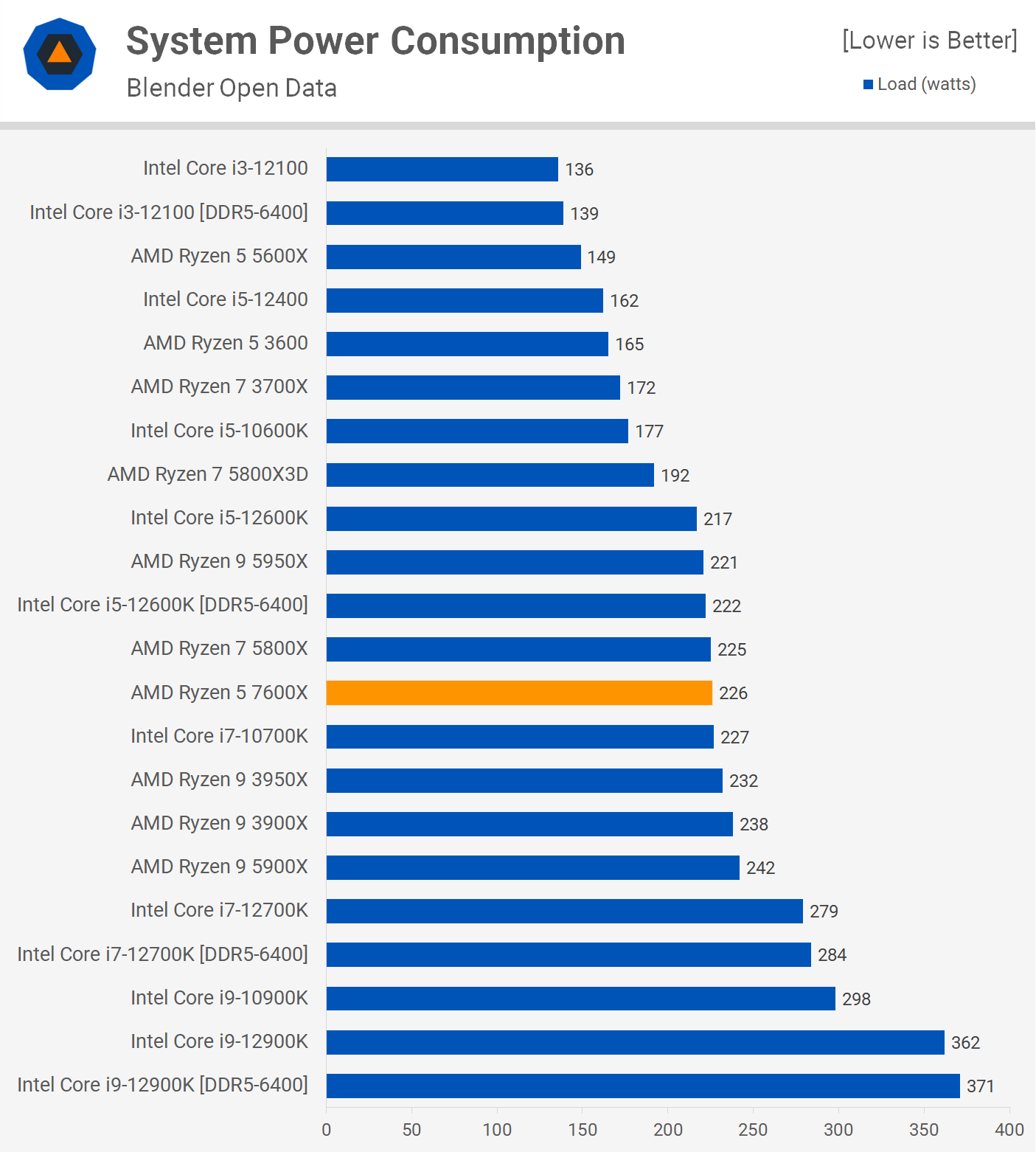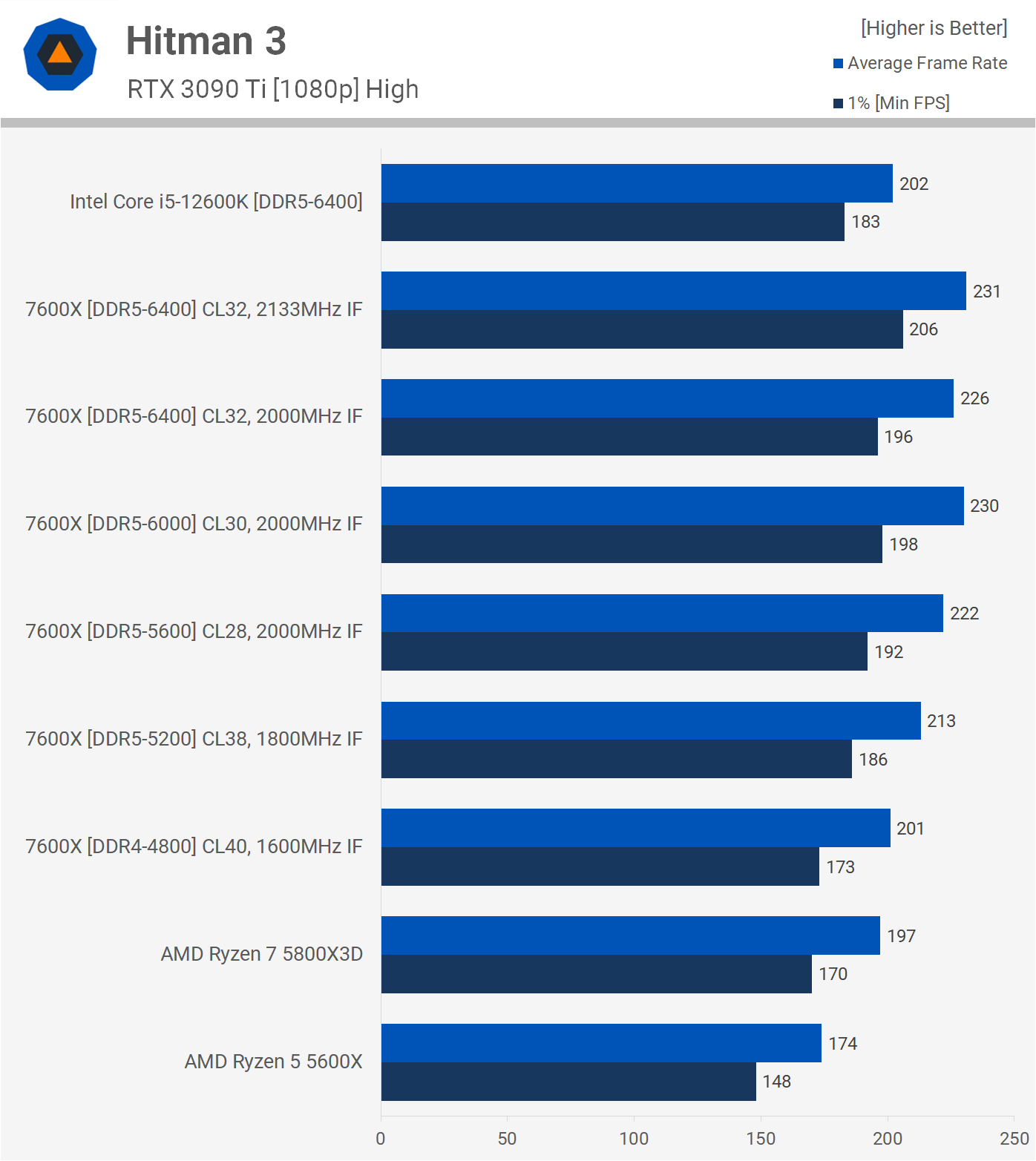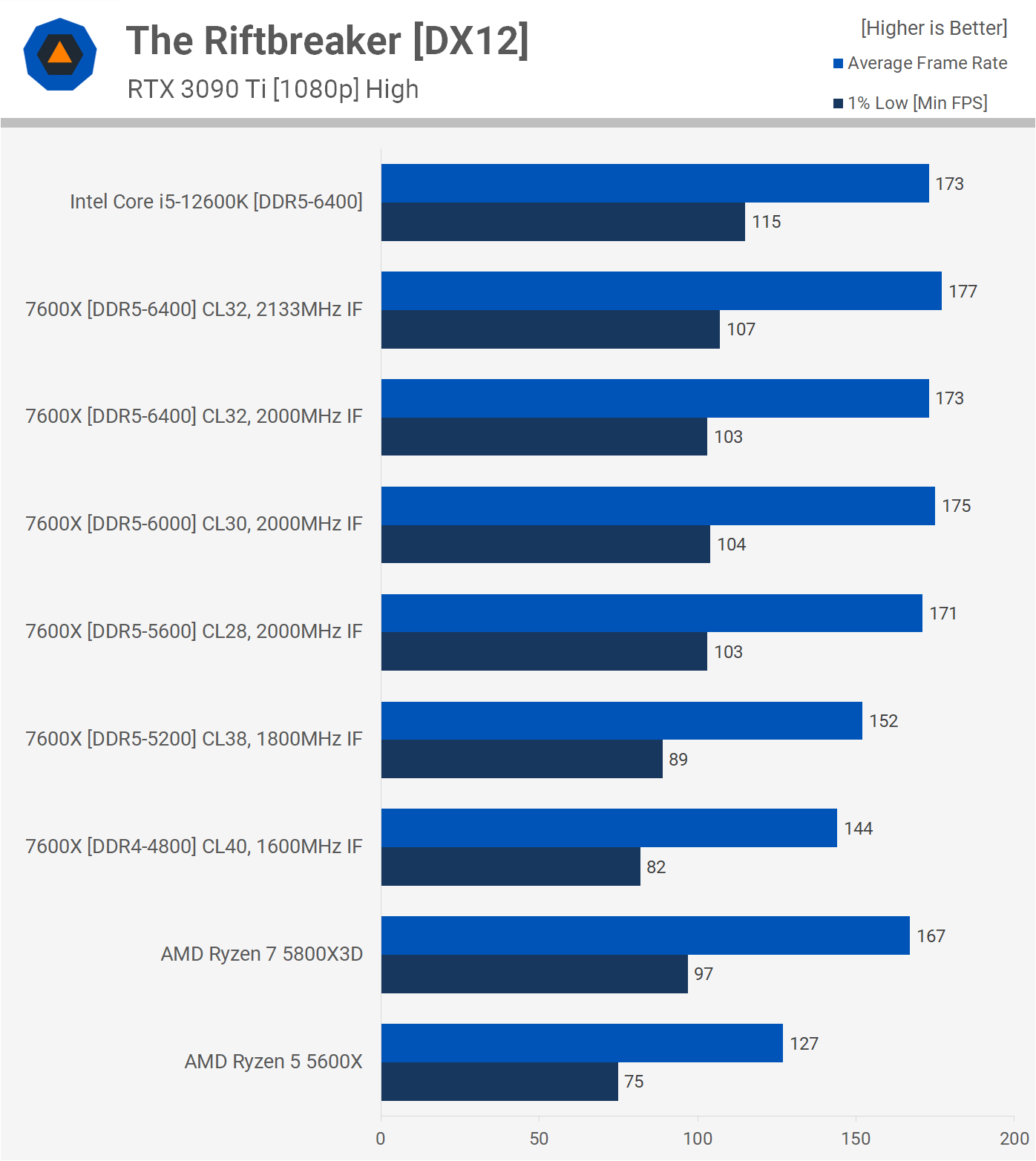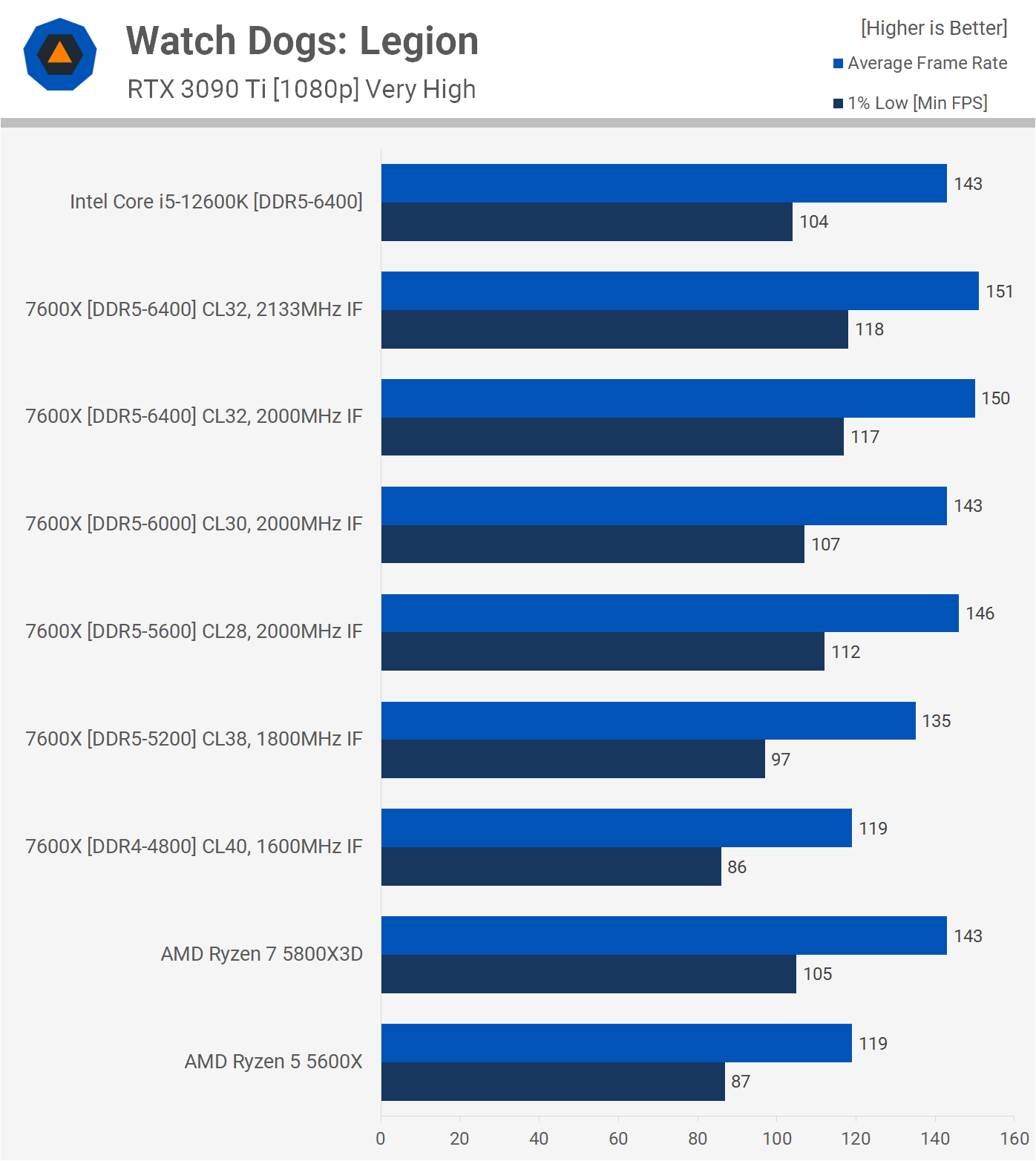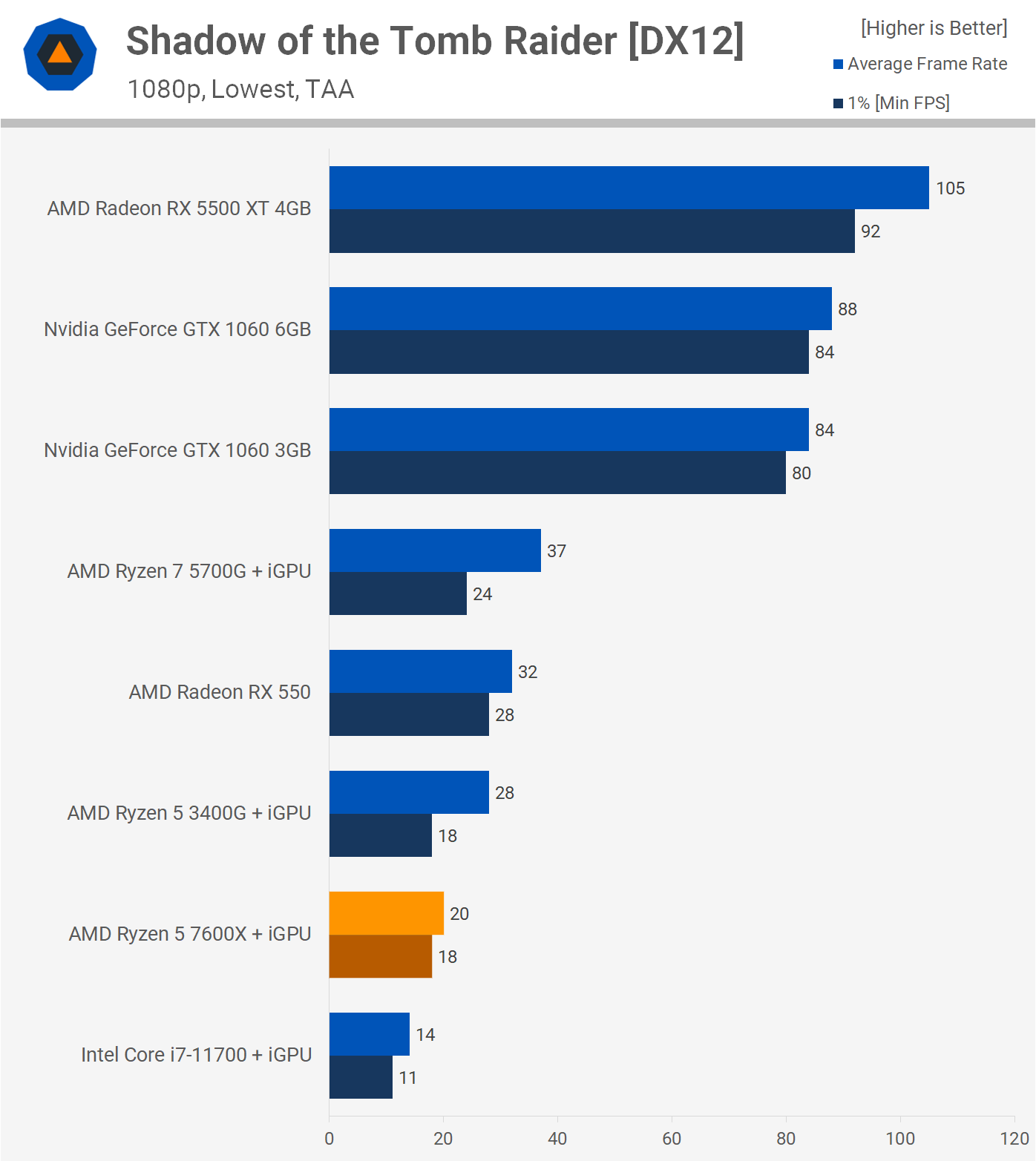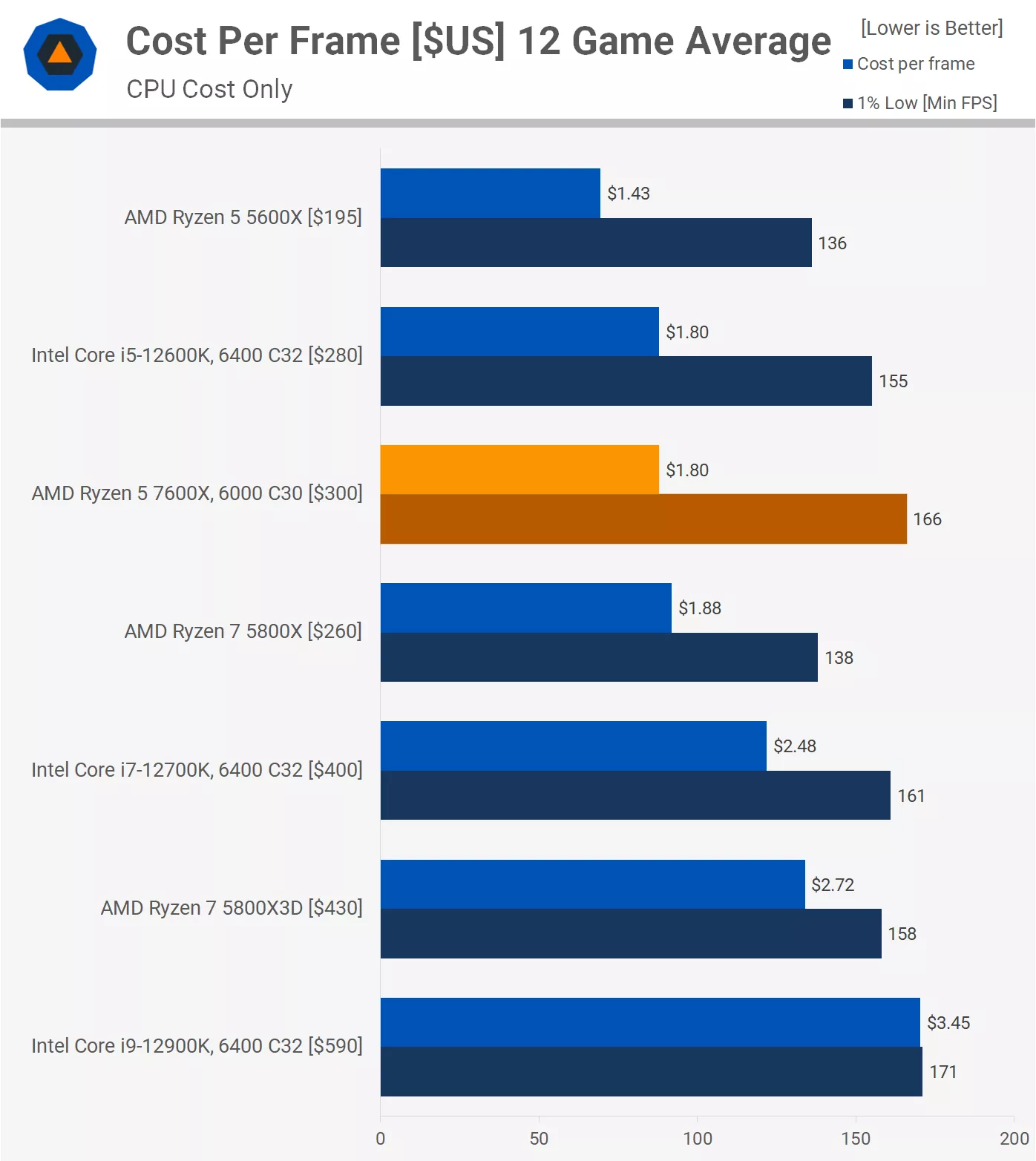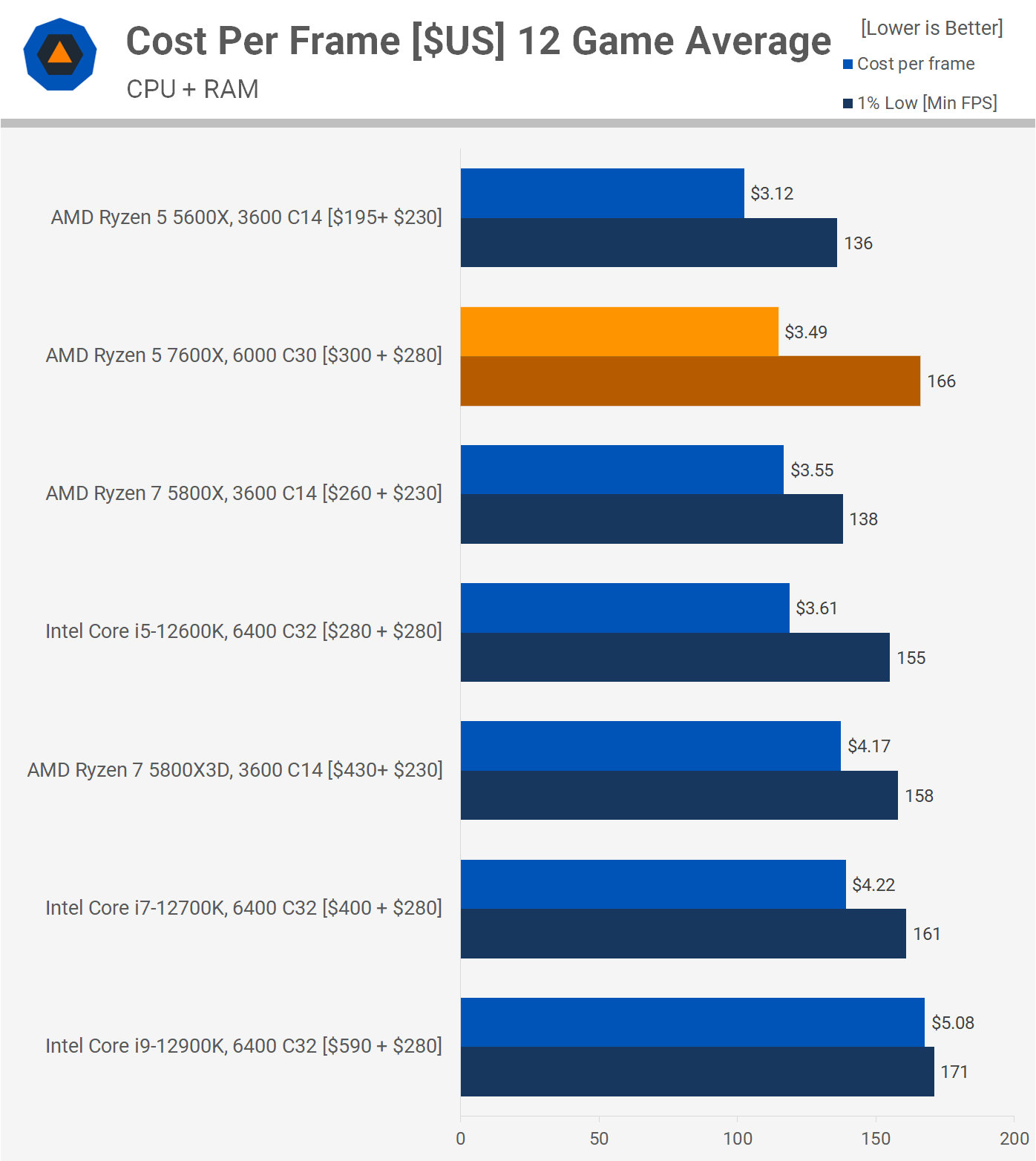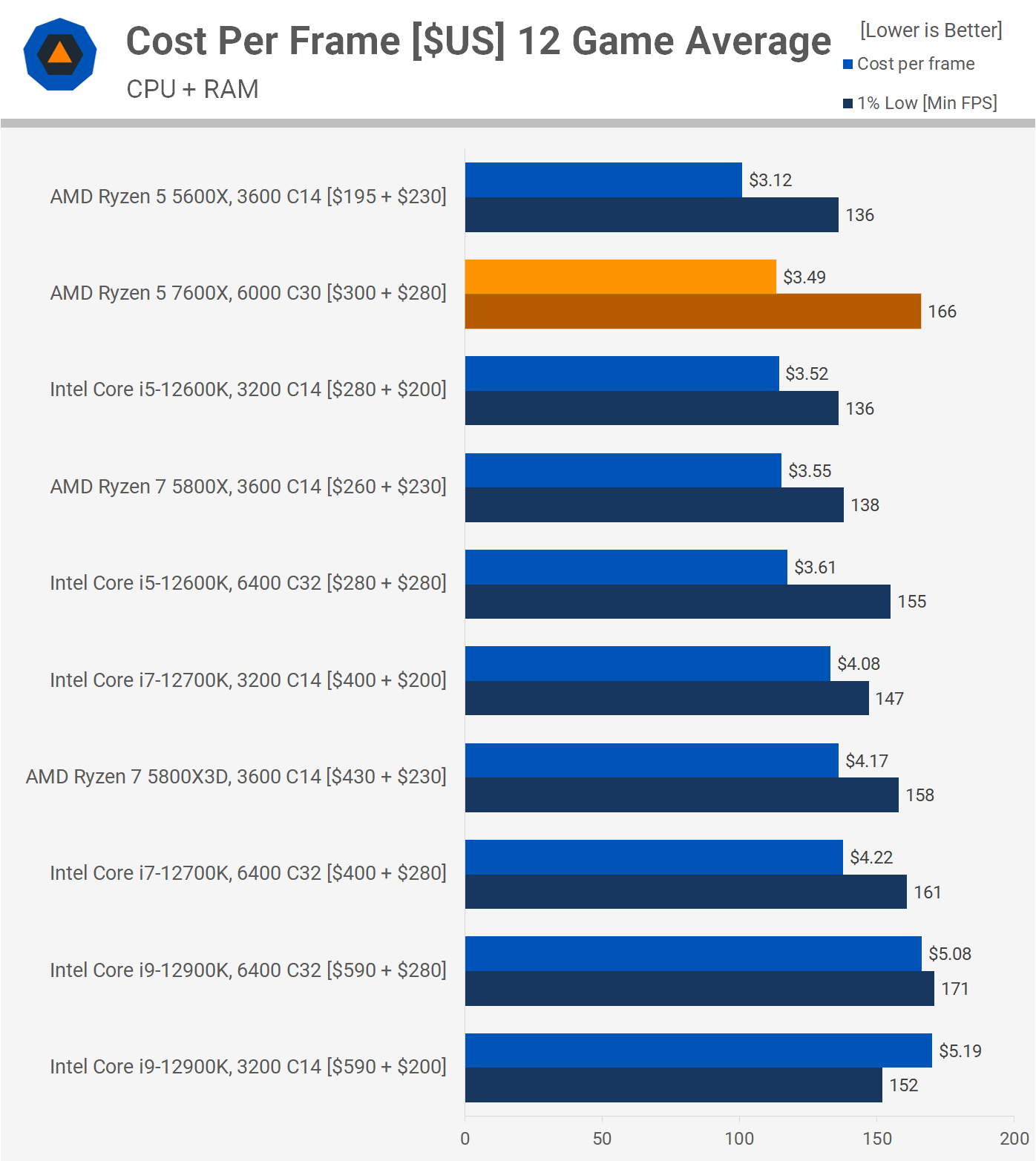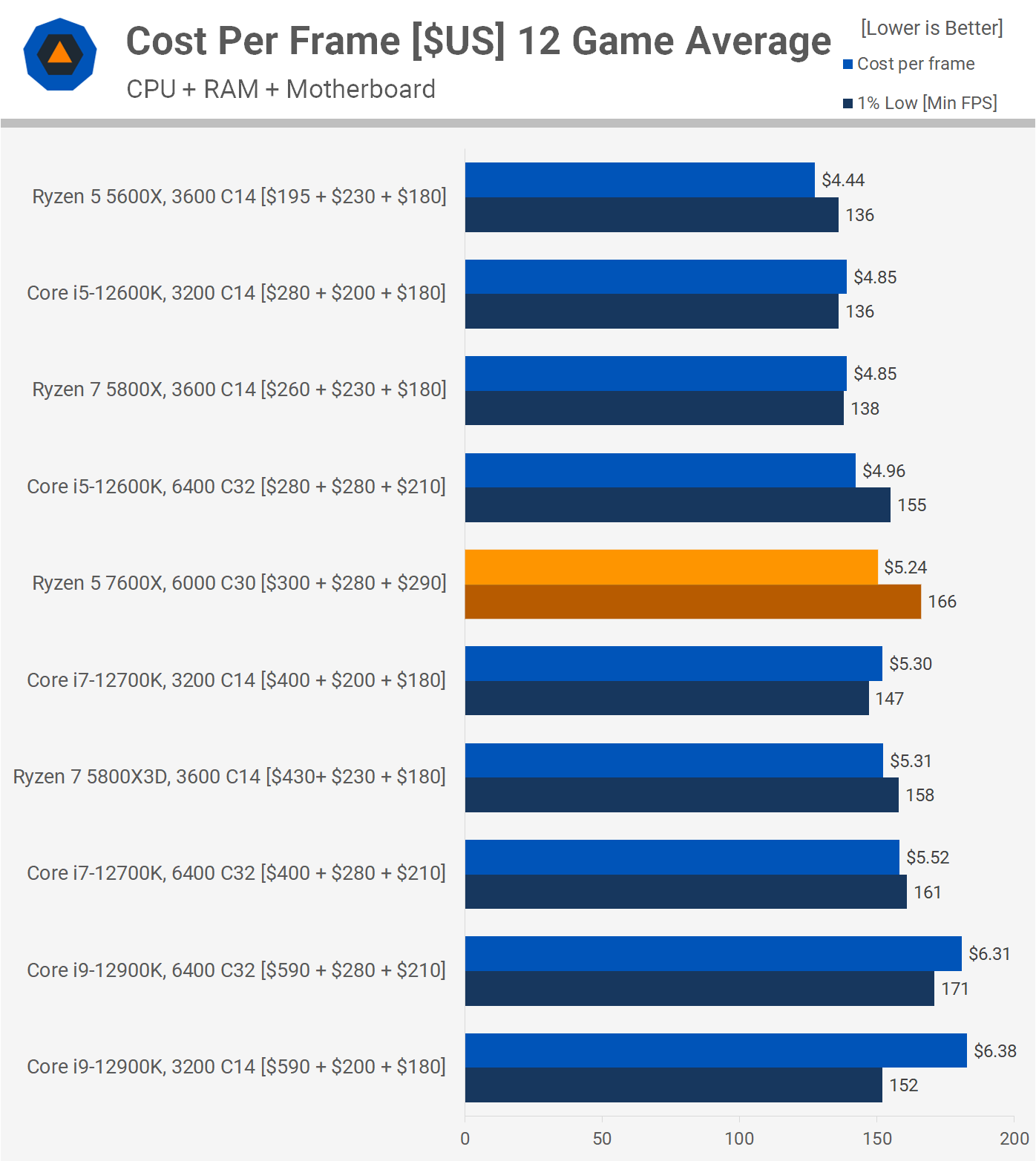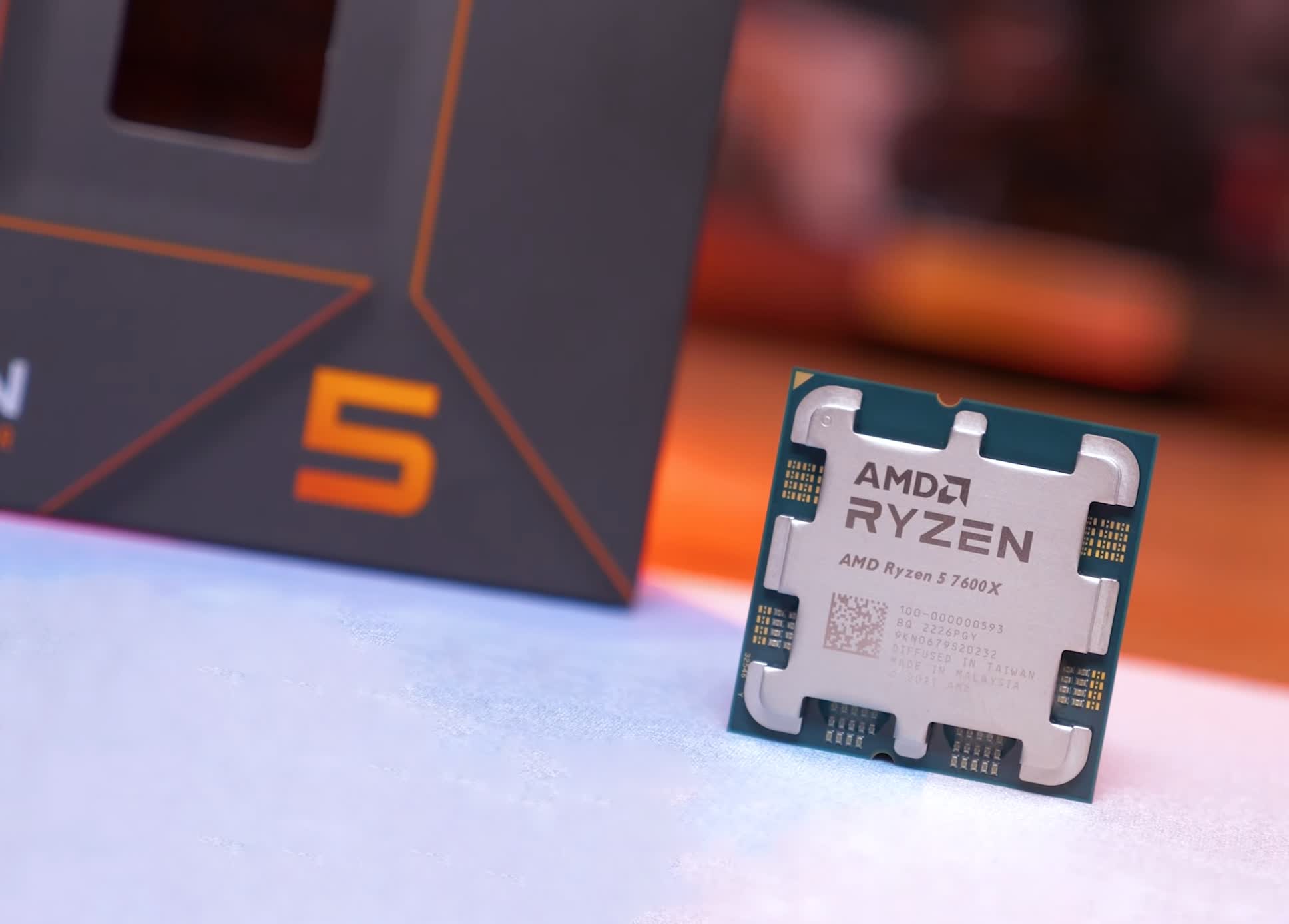Today we’re checking out our first Ryzen 7000 series processor, the Ryzen 5 7600X. We’ve decided to start with the most affordable CPU in the line-up as we suspect this is the model most of you will be interested in, but not to worry as we also have upcoming reviews for the 7700X, 7900X and 7950X and those reviews will be published this week.
Instead of grouping all four CPUs into a single review we decided to take a closer look at each model, run a few interesting tests and compare each model to its competitors.
The Ryzen 5 7600X is a 6-core, 12-thread processor that clocks between 4.7 GHz and 5.3 GHz depending on the load, it’s composed of a single 5nm Core Complex Die (CCD) along with a 6nm I/O die, packs 32MB of L3 cache, 6MB of L2, DDR5 support, 28 PCIe 5.0 lanes, a 105w TDP and is designed for the new AM5 socket.
When compared to Zen 3, new Zen 4 CPUs boost peak clock speeds by 16% to 5.7 GHz, improve IPC by 13%, double the L2 cache capacity, integrate an RDNA2 graphics solution and are built using TSMC’s 5nm process.
Coming from the 5600X, the Ryzen 5 7600X is also arriving at $300, so it’s a mainstream offering. While some might scoff at that price for a mere 6 cores, it’s expected to be much faster than the 5600X, so perhaps the price will be easier to justify and by the end of this review we’ll have our answer.
There’s a lot more ground to cover with these new Ryzen CPUs, but we’ll talk about many of the new features and changes as we work through the review. In anticipation for this launch, we’ve been busy updating all our CPU data for a few weeks and as a result we have 17 tested CPUs for comparison.
For the AM4 platform we’ve got a range of Zen 2 and Zen 3 CPUs, including but not limited to popular models such as the Ryzen 5 3600, Ryzen 7 3700X, and of course, the Ryzen 5 5600X.
Then on Intel’s front we have some Intel 10th-gen Core models — we decided to skip 11th-gen as that was a bit of a flop — and 12th-gen Core series processors using DDR4-3200 dual-rank CL14 memory and DDR5-6400 single-rank CL32 memory. The likes of the Core i3-12100 up to the Core i9-12900K have been included for comparison.
Our AM5 test system was configured using the MSI MEG X670E ACE. AMD insisted all reviewers use the supplied DDR5-6000 CL30 memory, so that’s what we’ve done. However, we have also added testing with DDR5-6400 memory, amongst other things and you’ll see all of that in this review.
All testing was conducted using the GeForce RTX 3090 Ti, Windows 11 and Resizable BAR was enabled for all configurations. Now, let’s get into it…
Clock Speeds
Before we dive into the blue bar graphs, here’s a look at clock behavior in Cinebench R23. After an hour of load testing, the R5 7600X maintained an all-core frequency of 5.2 GHz using the be quiet! Pure Loop 2 FX 360mm liquid cooler installed inside the Silent Base 802 case.
Interestingly, despite claiming a maximum boost frequency of 5.3 GHz, we saw the 7600X regularly running its core clocked at 5.45 GHz while running Cinebench R23, this behavior was seen on the MSI MEG X670E ACE.
Application Benchmarks
Starting with the Cinebench R23 multi-core results, we see that the new 7600X is basically on par with the 5800X, a Zen 3 8-core/16-thread processor. So even though the 5800X packs 33% more cores, the frequency and IPC uplift of the Zen 4-based 7600X gets it side to side with the higher core count model.
With a score of just over 15,000 pts, the 7600X is 24% faster than the 3700X and amazingly just 6% slower than the 10-core/20-thread Core i9-10900K.
That said, critically it is 12% slower than the Core i5-12600K, so for core-heavy productivity workloads the 7600X will have its work cut out for it.
As expected, the single-core performance looks amazing, matching Intel Alder Lake Core i5 and i7 parts. When compared to the 5600X we’re looking at a 28% improvement in single core performance and almost 60% boost from the old Ryzen 5 3600.
Moving on to the 7-Zip File Manager Compression test, we find strong performance from the 7600X and this time it’s able to edge out the 12600K, even when pairing the Intel CPU with DDR5-6400 memory.
This means another 28% uplift from the 5600X as it was slightly faster than the 5800X and 5800X3D. In fact, we’re really looking at 3900X-level performance which is insane when you think that CPU packs twice as many cores — granted, older Zen 2 cores.
The decompression performance is mixed, when compared to the 3900X it’s now 26% slower, but it was only 8% slower than the 5800X. Meanwhile, it matched the Core i9-10900K and edged the 12600K out by almost 20%, and that’s with the Alder Lake Core i5 using DDR4-6400 memory.
Next, we have the Blender Open Data benchmark where the 7600X is neck and neck with the Core i5-12600K, making it slightly faster than the 5800X3D, or slightly slower than the 5800X.
Overall another impressive result that sees the new hexa-core Zen 4 outperforming its predecessor by a whopping 40% margin.
The Corona 1.3 Benchmark shows more of the same, here the 7600X was only a fraction slower than the 5800X, but roughly 40% faster than the 5600X.
Disappointingly, it was slower than the 12600K by an 8% margin, not a huge loss but still disappointing to see.
For scrubbing through timelines and playing back 4K footage in Premiere Pro 2022, the 7600X is very mighty for a 6-core CPU, beating the 5800X in the Puget Systems Benchmark, as well as the Core i9-12900K.
An easy win over the 12600K in this instance, beating the 12600K by a 26% margin.
The 7600X was also impressive in the Puget Photoshop benchmark, falling just short of the 12900K, making it 16% faster than the 12600K running DDR5-6400. This is a massive 30% uplift from the 5600X and a 61% improvement over the Ryzen 5 3600.
The last Adobe application test we have is After Effects and again the 7600X does very well, beating all Zen 3 CPUs to narrowly edge out the Core i5-12600K, and losing only to the 12700K and 12900K.
In short, we’re looking at a 36% boost over the 5600X and a 57% boost over the 3600.
This benchmark looks at compilation performance, where the 7600X is roughly on par with the 12600K, making it 21% slower than the 5900X and given that CPU packs twice as many cores, that’s a stellar result. We’re also looking at a 54% performance improvement from the 5600X, which is pretty insane.
Gaming Benchmarks
We’ll kick off gaming benchmarks with Factorio, which is very cache sensitive, and only looks at single-core performance.
The 7600X was just 6% slower than the 12900K using DDR5-6400 memory and 12% faster than the 12600K, also using DDR5. Compared to the 5600X, we’re looking at a 19% improvement and then another jaw-dropping 63% increase over the old Ryzen 5 3600.
Now for the Watch Dogs: Legion results and we’d say we’re off to a good start here, 143 fps places it alongside the 5800X3D and 12600K using DDR5.
It was slower than the 12900K by a 9% margin, but given the price we’d say that’s a stellar result, it was also a 20% uplift over the 5600X and a 14% boost from the 5950X.
The Rainbow Six Extraction results are a bit unexpected as the 7600X was slightly slower than the 5600X. Performance overall was not terrible though as the 7600X was just 5% behind than the fastest CPU (12900K running DDR5).
A game where the 7600X does impress is Hitman 3, damn it’s fast here beating the 12900K using faster DDR5-6400 memory with 230 fps on average.
This meant it was 14% faster than the 12600K using DDR5 and 17% faster than the 5800X3D, while destroying AMD’s previous 6-core part, the 5600X, by a convincing 32% margin.
We’ve included Tiny Tina’s Wonderlands because it’s a super demanding game on the CPU and also a good representation of how CPU demanding many modern games are. That is to say, when using a relatively modern CPU, most games are going to be CPU bound, even when using an RTX 3090 Ti at 1080p as we see in this example.
This game can be useful for testing low-end CPUs, but for the 7600X it just shows us that we’re able to max out the RTX 3090 Ti, matching other high-end CPUs.
F1 22 is another excellent showing for the 7600X, pumping out 334 fps making it faster than even the 5800X3D, which was the previous champion in this title.
The 7600X is 10% faster than the 12900K using DDR5-6400 and an impressive 22% faster than the 12600K, also using DDR5-6400. We’re also looking at a 27% performance boost over the 5600X and a mind-blowing 78% increase over the 3600.
The Spider-Man Remastered performance is also impressive despite the fact that the 7600X only matched the 12600K, making it quite slower than the 12900K.
Still, it did beat the 5800X3D, and quite convincingly when looking at the 1% lows which are often helped by the higher frequency DDR5 memory. When compared to the 5600X, the 7600X was faster by an impressive 24% margin.
The 7600X matched the 5800X3D in Shadow of the Tomb Raider with 189 fps on average, making it 1.5% slower than the Alder Lake CPUs, a margin it can likely make up using DDR5-6400 memory and that’s something we’ll look into shortly. Performance overall is solid, and we’re looking at a decent 13% uplift over the 5600X.
Moving on to Horizon Zero Dawn, the 7600X shines again, delivering by far our best result with 211 fps on average. This made it 7% faster than the 5800X3D and 13% faster than the 12900K using DDR5 and then a massive 28% faster than the 12600K. Total domination over the Intel CPUs for the new Ryzen 5 7600X in this title.
Now, a game where Ryzen doesn’t typically shine is Cyberpunk 2077 and that’s still true of the 7600X. The overall result is still good, beating the 5800X3D by a 6% margin and the 5600X by a 10% margin. However, when compared to Alder Lake the results are a little underwhelming as it trailed the 12600K using DDR5 by a 5% margin and the 12900K by a 15% margin.
As a side note, if you’re wondering why we keep comparing AMD’s new $300 CPU to Intel’s 12900K, it’s because AMD made those claims saying that overall the 7600X is faster, so we’re certainly going to look at that.
ACC was a game where the 5800X3D completely shredded and unfortunately the 7600X simply can’t live with it in this one, trailing the 3D part by a large 14% margin.
It was the next best thing though, beating the Core i9-12900K by a 3% margin and the 12600K using DDR5 by a massive 20% margin. So, a highly positive result overall.
Traditionally, AMD CPUs have kind of sucked in The Riftbreaker relative to Intel, even the 5800X3D struggled to knock off the Alder Lake parts and while the 7600X couldn’t beat the 12900K using DDR5, it did edge out the 12600K by a slim margin.
Counter-Strike: Global Offensive is another ripper for the 7600X, pumping out 487 fps with the RTX 3090 Ti to make it the fastest CPU we’ve tested to date.
This result makes the Zen 4 CPU 8% faster than the 12900K using DDR5 and a massive 32% faster than the 12600K. This is a single-core game that relies on single-thread performance, which is why the 7600X does so well and the restructured cache probably helps a lot as well.
12 Game Average Performance
As expected the Ryzen 5 7600X is right up there with the 12900K using DDR5 memory, giving it a fairly comfortable 9% lead over the 12600K, also using high speed DDR5 memory.
Impressively, it also beat the 5800X3D, only by a 4% margin, but that’s a great overall result that we think few would have expected.
When compared to the Ryzen 5 5600X, which is still an exceptionally good gaming CPU, the 7600X is on average 19% faster which is a solid generation on generation uplift.
For those of you still rocking a Ryzen 5 3600 and have been hanging out for an upgrade, the 54% uplift average offered by the 7600X will be hard to refuse, even if you do have to upgrade your motherboard and memory. The 5800X3D might be an easier and more cost-effective means of achieving that level of performance though.
Power Consumption
Taking a look at total system consumption, given the extremely high operating frequency of the 7600X, it’s probably of little surprise to learn that it consumes a similar level of power to that of the 5800X, reading a total system draw of 226 watts.
Performance was also on par with the 5800X, so we’re looking at comparable performance per watt to Zen 3, as well as Intel’s Alder Lake architecture, at least when comparing the 12600K and 7600X. As far as power supply requirements go, we’re looking at pretty basic demands here.
Cooling Performance
AMD Zen 4 CPUs intentionally give the impression that they’re difficult to cool by delivering as much performance as possible by taking full advantage of the thermal and power headroom.
AMD says with the new AM5 socket and higher TDP, Zen 4 processors will run into a thermal wall before they hit a power wall. This means that under heavy load they’ll sit at TJMax which is about 95 degrees Celsius for the Ryzen 7000 series, and this will be particularly true for the 12 and 16-core models.
AMD has stressed that this behavior is intended and by design and say it’s important to note TJMax is the maximum safe operating temperature — not the absolute maximum temperature. In the case of Zen 4, the processors are designed to run at TJMax 24/7 without risk of damage or deterioration. AMD went on to say that 95C is not running hot, rather Zen 4 will intentionally go to this temperature as much as possible under load because the power management system knows that this is the ideal way to squeeze the most performance out of the chip without damaging it.
Regarding the move from the 1331-pin PGA AM4 socket to 1718-pin LGA for AM5, the good news is that almost all AM4 coolers will be compatible with AM5, except for those that are secured from the rear side of the motherboard as the backplates aren’t removable from AM5 boards.
This means that all coolers can now be installed without requiring rear access to the motherboard, as is the case with HEDT processors, so that’s great.
For testing we used the be quiet! Pure Loop 2 FX 360mm liquid cooler which is fully AM5 compatible. After an hour of looping Cinebench multi-core we recorded a peak CPU temperature of 93C, just shy of the 95C TJMax that AMD says the CPU targets for maximum performance. This allowed for a sustained all-core frequency of 5.2 GHz, delivering the performance shown in this review. It will be interesting to revisit these Zen 4 processors using a range of coolers to see how cooling performance affects CPU performance. But that’s an investigation for another time.
RAM Performance
As we noted earlier, AMD provided DDR5-6000 CL30 memory for our testing and this done with all reviewers as AMD believes this to be the sweet-spot memory for Zen 4.
The default Fabric frequency for Zen 4 CPUs is 1733 MHz for DDR5-5200 as this is the official memory speed. However, as is often the case, higher memory speeds can be achieved and with AMD pointing to DDR5-6000 as the sweet spot, it is to be assumed that all Zen 4 CPUs will handle a Fabric frequency of 2000 MHz.
Previously, with Ryzen 5000 series CPUs, you wanted to keep the FCLK, UCLK and MCLK tied at a 1:1:1 ratio for optimal performance, but with Zen 4 that’s no longer the case. Rather, the memory controller or IMC is best kept at a 1:1 ratio with the DDR5 memory, while the Fabric operates at a 3:2 ratio. For example, using DDR5-4800 would see the IMC run at 2400 MHz and the Fabric at 1600 MHz, or DDR5-6000 which saw the IMC run at 3000 MHz and the Fabric at 2000 MHz.
We tried a few different DDR5 memory kits and here are the results. In Hitman 3 we see that the DDR5-6000 kit was good for 230 fps and we were unable to beat that by a convincing margin with DDR5-6400 memory and a Fabric frequency of 2133 MHz, though the 1% lows were improved by 4%.
Running the DDR5-6400 memory with the Fabric set to 2000 MHz reduced performance, so as AMD suggested that is a sub-optimal configuration. With DDR5-5600 you’d ideally want a Fabric speed of 1866 MHz, but that didn’t exist, with either 1800 or 2000 MHz being the nearest options, so we went with 2000 MHz. Here DDR5-5600 was just 3% slower than DDR5-6000. Then we see that 5200 is 7% slower than 6000 and finally the cheap 8GB DDR5-4800 modules that we recently purchased were 13% slower, far from ideal though in this particular title that was enough to match the 12600K using DDR5-6400 as well as the 5800X3D.
When testing with the The Riftbreaker, we see that DDR5-5600 and up delivered pretty much the same result, though this time DDR5-6400 using a 2133 MHz Fabric frequency did provide the best results. We only saw a noticeable drop off in performance with the DDR5-5200 and 4800 memory.
Spider-Man Remastered is sensitive to memory bandwidth and here we found that DDR5-6400 was faster even when running the Fabric at 2000 MHz. When using the same configuration as the Core i5-12600K (DDR5-6400), the 7600X was 7% faster in this title, whereas it only matched the 12600K using DDR5-6000.
Watch Dogs Legion has more interesting data for us, here the DDR5-6400 memory boosted the 1% lows of the 7600X by 10% and the average frame rate by 6% and this again pushed it ahead of the 12600K, whereas previously both delivered the same level of performance when pairing the Ryzen 5 processor with 6000 memory.
1 DPC vs. 2 DPC Performance
Something else we were interested in testing was how the 7600X handled with all DIMM slots populated with DDR5. Would DDR5-6000 still be possible or would we be reduced to a lower memory frequency? The IMC of our 12600K, for example, can’t handle the stress of four DDR5-6000 modules and will blue screen when gaming.
AMD’s official memory specification for Zen 4 is DDR5-5200 as we’ve already noted, but that’s for a 1 DPC configuration, in other words when using two memory modules. For a 2 DPC configuration, so when populating all four DIMM slots, the frequency drops to just DDR5-3600, and this sounds quite alarming.
The good news is that all Zen 4 CPUs will apparently handle at least 5200 as our 7600X CPU ran flawlessly with four DDR5-6000 modules. This provided a very minor performance bump, though for the most part frame rates will be much the same using either 2 or 4 DDR5-6000 modules.
Resizable BAR Performance
We’re sure some of you were wondering if Resizable BAR (or AMD’s SAM) performance has been improved with Zen 4, so here are some results. We should note that with AM5 Resizable Bar is now enabled by default.
Checking out performance with the Radeon 6950 XT we’re seeing very typical scaling to what we’ve seen with Zen 3 and Alder Lake. Horizon Zero Dawn saw a 14% uplift, 16% for Assassin’s Creed Valhalla and 15% for Halo Infinite, so nothing out of the ordinary here.
Integrated Graphics (iGPU) Performance
The last benchmark of the day looks at the 7600X’s iGPU, which isn’t intended for serious gaming, but then again, we know some of you will want to see the results.
The iGPU is as useless for gaming as Intel integrated graphics, which will result in a ~20 fps average in Shadow of the Tomb Raider using the lowest possible quality settings at 1080p.
The iGPU is just there so Zen 4 can better compete with Intel’s CPUs which include a weak iGPU, making Zen 4 more attractive for office use, basic laptops or for use in a HTPC. You do get features such as AV1 decoding, H.264 & HEVC decode and encode, DisplayPort 2.0 and HDMI 2.1 support along with USB Type-C.
Performance Summary: Productivity
That’s the end of the benchmarks, but there’s a lot of things to discuss and we’ll start with productivity performance. For core-heavy workloads, the Ryzen 5 7600X essentially performance like a 5800X, and similar to the Core i5-12600K. That’s not overly impressive considering both the 5800X and 12600K cost around $270, can be paired with cheaper motherboards, and it simply doesn’t move the needle forward in this scenario.
For lightly threaded applications such as Photoshop, the 7600X is more impressive offering around 15% more performance than the 12600K and almost 20% more than the 5800X. In this case scenario, if time was money, you could justify the upgrade depending on the applications you’re running, as there’s a good chance the 12600K will offer a similar level of performance.
The Ryzen 5 7600X is not a productivity monster. That title will likely go to the new Ryzen 9 parts and we’ll be taking a look at the 16-core model in tomorrow’s review.
Performance Summary: Gaming + Cost per Frame
The Ryzen 5 7600X is a fast gaming CPU, roughly matching the 12700K and 12900K in our 12 game sample, and even edging out the Ryzen 7 5800X3D which is mighty impressive.
It’s also got the 12600K’s number winning by ~10%, a margin that might grow a little had we used 6400 memory rather than 6000.
Cost per Frame: CPU Only
Based on the 1% low data from our 12-game average, if we were to just look at the CPU, from a value perspective the 7600X isn’t amazing, certainly not to the degree that we’d say you should rush out and buy it.
Yes, performance overall is pretty great, but at $300 it’s not earth shattering, matching the cost per frame of the 12600K and edging out the 5800X by a mere 4%, though the 5700X would jump ahead here.
Then when compared to the 5600X, the 7600X is coming in 26% more expensive in cost per frame, and that margin could grow to as much as 50% if we were to use the cheaper $160 5600.
Having said all of that, those of you after Core i7-12700K-like performance, AMD’s 7600X represents great value, saving you almost 30% per frame and it’s significantly better value than the much loved 5800X3D, so it’s by no means bad value for a high performance CPU.
Cost per Frame: CPU + RAM
But what if we add in the cost of a 32GB memory kit? On AM4 the $230 DDR4-3600 CL14 kit would be around 5% faster than what we showed here, but let’s stick with the numbers we have for now.
The DDR5-6000 CL30 and 6400 CL32 kits both cost $280, but despite increasing the cost of the 7600X, it actually helps better position it as overall costs of all options have increased and now the total cost for the 7600X option is 36% higher than that of the 5600X, whereas before when just accounting for the CPU it was 54% more expensive.
So, despite the higher price of DDR5 memory, if you want 32GB, the value of the 7600X isn’t too bad relative to existing AM4 CPUs, and again it matched the 12600K.
Of course, the 5600X works well with just 16GB in a majority of games, so for budget conscious shoppers it’s still a much better value option. If saving money is the priority, then you’d go with either the Ryzen 5 5600 (non-X) or something like the Core i5-12400.
But if you’re seeking premium performance, the 7600X certainly looks good, beating the Core i7-12700K overall while costing 17% less per frame even when including the cost of memory.
Cost per Frame: CPU + RAM + DDR4
You can also pair Intel Alder Lake CPUs with DDR4 memory and a 32GB kit of DDR4-3200 CL14 memory costs $200, so there’s a reasonable saving compared to DDR5.
If we include the DDR4 numbers for Intel’s 12th-gen we see that the 12600K creeps closer to the 7600X in terms of value, but higher-end parts like the 12700K still can’t compete.
Cost per Frame: CPU + RAM + DDR4 + Motherboard
And that brings us to cost per frame data including the entire platform: CPU, memory, and also the motherboard, and this one is a real kick in the teeth for those of you hoping to upgrade to AM5.
We’ll use MSI as a price gauge as they were able to provide MSRP pricing of their entire range. The base MSI Pro X670-P WiFi which is an X670 board and not an X670E board, is brutally expensive at $290. For context, the equivalent Z690 board (MSI Pro Z690-A DDR5) is $210 but we’ve seen it discounted as low as $160. You can certainly purchase a Z690 DDR5 board for around $160, but we’ll use the $210 pricing as that generally lands you a much higher quality motherboard, and still means the base model MSI X670 board will cost almost 40% more.
For the DDR4 12th-gen configurations you can get a good quality board such as the MSI Pro Z690-P DDR4 for $180, and for the AM4 CPUs the Asus TUF Gaming X570-Plus WiFi for $180 is a great value option. We know there are cheaper B550 boards, but we’re not looking at budget CPUs here. As before, if you’re wanting to save money and focus more on value, the 7600X is not the CPU for you, think Ryzen 5 5600 or Core i5-12400 instead.
With all those prices punched in, we see that the 7600X package has dropped towards the middle of our graph. When compared to the 12600K using DDR5 memory it’s ~6% more expensive per frame, which is not bad but not amazing either.
The 12600K using DDR4 isn’t much better and it’s not until we drop down to the much cheaper 5600X that we see a significant saving of 18% per frame.
What We Learned
The Ryzen 5 7600X can be both: a really impressive CPU, offering high-end gaming performance at a very competitive price, or also disappointing if you want best value and, in that case, existing products typically offer a similar level of performance for less.
For value conscious shoppers, AM5 simply won’t be too appealing for now as the cost of the CPUs and premium DDR5 memory, plus the cost of X670 motherboards all add up. Value shoppers will still turn to AM4 or Intel’s 12th-gen, and personally we think it’s hard to go past the Core i5-12400F on a decent B660 board, when you can essentially get the CPU and motherboard for less than the cost of the 7600X.
For high-end shoppers though, the Ryzen 5 7600X is a great performance-value offering. While it’s only 7-10% faster than the 12600K depending on which metric you look at, we think this graph paints a pretty picture for Zen 4. The reason is that for nearly half the games tested the 7600X is a good bit faster and we see numerous examples where the margin goes as high as 20% or more.
The real killer for AM5 at launch is motherboard pricing. Had the MSRP for the entry-level MSI board been closer to $200 then the 7600X would be a no-brainer, offering a similar cost per frame to that the 5600X when looking at the complete platform cost. Pricing for X670 boards is expected to improve, but they’ll almost certainly command a heavy premium for the remainder of this year. AMD has promised AM5 boards will start at $125 and we expect that’ll happen with B650 boards eventually.
There’s an elephant in the room called platform support. We expect Intel to axe their current platform after Raptor Lake, meaning any upgrade beyond that will require a new motherboard. Meanwhile, AMD has already committed to the AM5 socket through 2025 which should see at least two more CPU generations on AM5.
In other words, while AM5 motherboard pricing might be high, buying a decent board now with the expectation of slotting in a future CPU for a big and very convenient upgrade is very appealing as we’ve already seen it happen with AM4 for the past few years. You might miss out on some new features, but for most, PCIe 5.0 is going to be more than sufficient for years to come.
It’s also worth noting that DDR5 memory has rapidly tumbled this year. Just 8 months ago a DDR5-6400 CL32 kit went as high as $610, having since dropped to $290, or a ~50% price reduction in less than a year. Going by that trend, we expect DDR5 will look even better by the end of 2022.
As for what type of DDR5 memory you should pair with Zen 4, it’s difficult to say. AMD claims DDR5-6000 is the sweet spot, but we saw good gains of up to 7% using DDR5-6400 on the 7600X. Stability wasn’t an issue with a Fabric frequency of 2133 MHz, so we’ll have to see if that’s the case for most CPUs. Plus, the 7600X had no trouble running at DDR5-6000 with four memory modules installed.
Bottom line, the Ryzen 5 7600X is a solid choice if you’re after a high-performance gaming system, but also for just $100 more we’re keen to see what the Ryzen 7 7700X has to offer. There’s also Intel’s 13th-gen Core a.k.a. Raptor Lake incoming, so we’d hold off on any purchase until those parts arrive as soon as next month.
And that’s where we’ll end our Ryzen 5 7600X review. Still loads of testing to do, lots of exciting big benchmarks planned, and of course, next-gen GPUs to try out on these CPUs as well, so stay tuned and we’ll get back to work.


